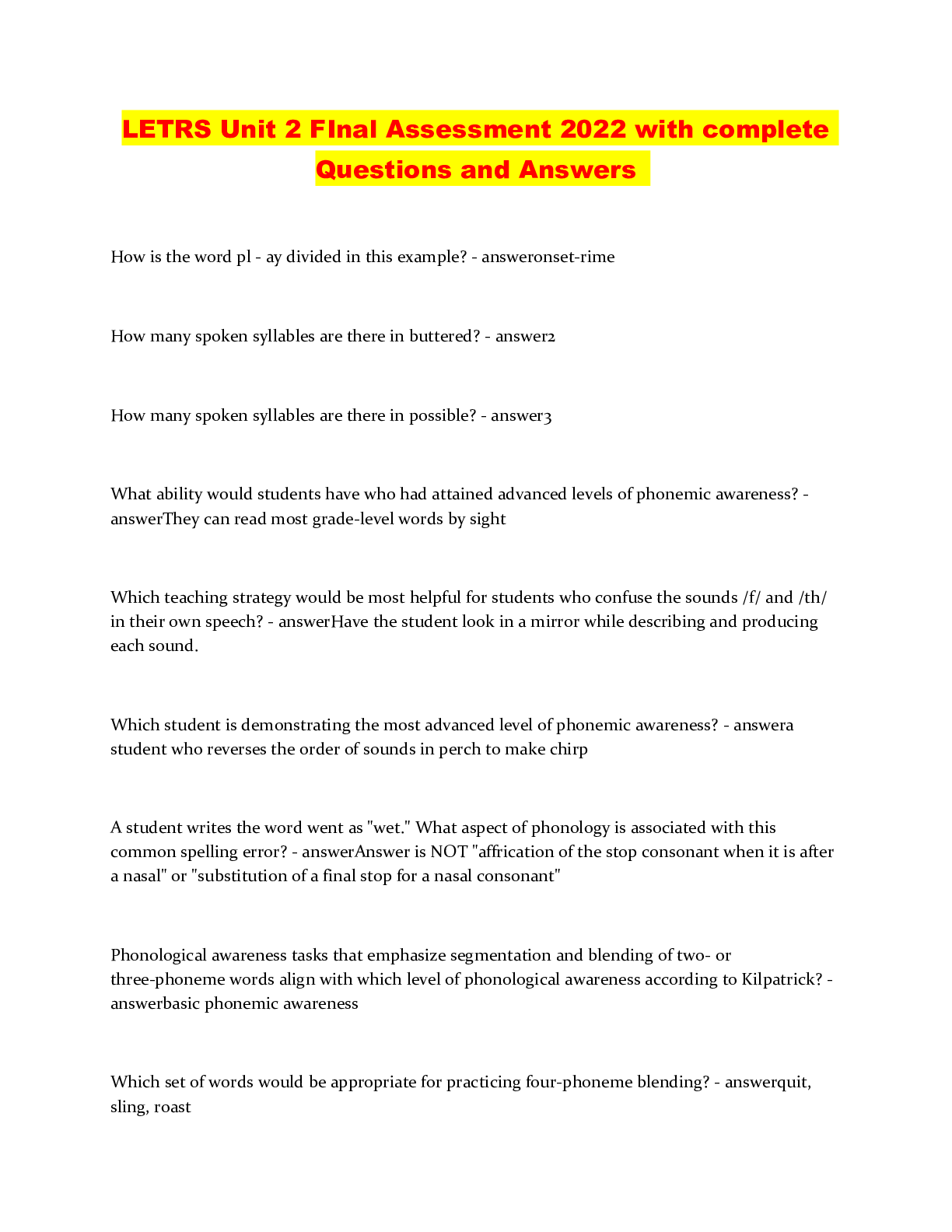*NURSING > QUESTIONS & ANSWERS > NUR 2212Multi-System (heart/vent). Questions, Answers and the Rationale. Top Grade All Correct (All)
NUR 2212Multi-System (heart/vent). Questions, Answers and the Rationale. Top Grade All Correct
Document Content and Description Below
NUR 2212Multi-System (heart/vent). Questions, Answers and the Rationale. Top Grade All Correct 1. A client with congestive heart failure is receiving intravenous digoxin (Cardoxin) therapy. The regist... ered nurse identifies that which items on the client’s c are plan are appropriate for a licensed practical nurse (LPN) to perform? Select all that apply. 1Help the client ambulate when required. 2 Monitor the client’s vitals every 30 minutes. 3 Administer adequate oral fluids to the client. 4 Prepare the nursing diagnosis after assessing the client. 5 Administer the digoxin (Cardoxin) if the client has chest pain. 2. A client is admitted to the hospital with a diagnosis of heart failure and acute pulmonary edema. The healthcare provider prescribes furosemide 40 mg intravenous (IV) stat to be repeated in 1 hour. What nursing action will best evaluate the effectiveness of the furosemide in managing the client’s condition? 1 Perform daily weights 2 Auscultate breath sounds 3 Monitor intake and output 4 Assess for dependent edema 3. A client is admitted to the hospital with the diagnosis of myocardial infarction. The nurse should monitor this client for which signs and symptoms associated with heart failure? Select all that apply. 1 Weight loss 2 Unusual fatigue 3 Dependent edema 4 Nocturnal dyspnea 5 Increased urinary output 4. How can the nurse best describe heart failure to a client? 1 A cardiac condition caused by inadequate circulating blood volume 2 An acute state in which the pulmonary circulation pressure decreases 3 An inability of the heart to pump blood in proportion to metabolic needs 4 A chronic state in which the systolic blood pressure drops below 90 mm Hg 5. A client with a history of heart failure admits to the nurse that a salt-restricted diet has not been followed. The client reports increased ankle swelling and shortness of breath that is relieved by sitting up. For which other clinical indicators of fluid retention should the nurse monitor the client? Select all that apply. 1 Headache 2 Thready pulse 3 Decreased blood pressure 4 Dizziness when standing up 5 Crackles on lung auscultation 6. A client with a history of heart failure is admitted to the hospital with the diagnosis of pulmonary edema. For which signs and symptoms specific to pulmonary edema should the nurse assess the client? Select all that apply. 1 Crackles 2 Coughing 3 Orthopnea 4 Yellow sputum 5 Dependent edema 7. An older adult client is diagnosed with left-sided congestive heart failure. Which assessments should the nurse expect to find? Select all that apply. 1 Dyspnea 2 Crackles 3 Hacking cough 4 Peripheral edema 5 Jugular distention 8. The primary healthcare provider has prescribed a stat chest x-ray exam and electrocardiogram for a client with a history of heart failure. The pulse oximeter has changed from 90% to 86% oxygen saturation. Which immediate actions will the nurse take? Select all that apply. 1 Instruct a staff member to get the electrocardiogram machine. 2 Call for a portable stat chest x-ray. 3 Have a staff member notify the nursing supervisor of the change in client status. 4 Notify the healthcare provider of the change in the oxygen saturation. 5 Tell the certified nursing assistant to get a prescription from the healthcare provider to increase the oxygen. 6 Increase the supplemental oxygen without a prescription from 2 L nasal cannula to 4 L nasal cannula. 9. A nurse begins to develop a plan of care with a client who has left ventricular heart failure that resulted from a myocardial infarction (MI). Which goal is priority during the acute phase of recovery? 1 Promote pain relief 2 Increase activity tolerance 3 Prevent cardiac dysrhythmias 4 Maintain potassium and sodium intake 10. A client with chronic heart failure is taking a diuretic twice a day. The healthcare provider prescribes a diet that includes the intake of foods high in dietary potassium. Which foods should the nurse instruct the client to consume? Select all that apply. 1 Corn 2 Bananas 3 Strawberries 4 Cucumber salad 5 Baked potatoes with skins A nurse is assessing sudden changes in the neurologic status of different clients after an earthquake. Which client should require endotracheal intubation and mechanical ventilation? 1 Client 1 2 Client 2 3 Client 3 4 Client 4 11. While caring for clients with injuries after a terrorist attack, the nurse observed ear bleeding, conjuctival hemorrhage, and severe lacerations in a client and provided mechanical ventilation. Which tag would be appropriate for this client according to the disaster triage tag system? 1 Red tag 2 Black tag 3 Green tag 4 Yellow tag 12. After an anterior fossa craniotomy, a client is placed on controlled mechanical ventilation. To ensure adequate cerebral blood flow, which action should the nurse take? 1 Clear the ear of draining fluid. 2 Discontinue anticonvulsant therapy. 3 Elevate the head of the bed 30 degrees. 4 Monitor serum carbon dioxide levels routinely. 13. A client with a pulmonary embolus is intubated and placed on mechanical ventilation. When suctioning the endotracheal tube, what should the nurse do? 1 Hyperoxygenate with 100% oxygen before and after suctioning 2 Suction two or three times in quick succession to remove secretions 3 Use the technique of short, pushing movements when applying suction 4 Apply suction for no more than 10 seconds while inserting the catheter 14. A client with acute respiratory distress syndrome is intubated and placed on a ventilator. What should the nurse do when caring for this client and the mechanical ventilator? 1 Deflate the cuff on the endotracheal tube for a few minutes every one to two hours. 2 Assess the need for suctioning when the high-pressure alarm of the ventilator is activated. 3 Adjust the temperature of fluid in the humidification chamber depending on the volume of gas delivered. 4 Regulate the positive end-expiratory pressure (PEEP) according to the rate and depth of the client's respirations. 15. When caring for an intubated client receiving mechanical ventilation, the nurse hears the high-pressure alarm. Which action is most appropriate? 1 Remove secretions by suctioning. 2 Lower the setting of the tidal volume. 3 Check that tubing connections are secure. 4 Obtain a specimen for arterial blood gases (ABGs). 16. A client has an endotracheal tube and is receiving mechanical ventilation. Periodic suctioning is necessary, and the nurse follows a specific protocol when performing this procedure. Select in order of priority the nursing actions that should be taken when suctioning. 1. Assess client's vital signs and lung sounds 2. Insert the catheter without applying suction 3. Activate the ventilator suction hyperoxygenation setting 4. Rotate the catheter while suction is applied 17. The nurse is admitting a pregnant client who has mitral valve stenosis to the high-risk unit. Which prophylactic medication does the nurse anticipate administering during the intrapartum period? 1 Diuretic 2 Antibiotic 3 Cardiotonic 4 Anticoagulant 18. Sublingual nitroglycerin is prescribed for a client with a history of a myocardial infarction and atrial tachycardia. The nurse instructs the client about the prophylactic use of these tablets. Which statement by the client indicates the teaching was effective? 1"I should take the medicine three times a day." 2 "I will be sure to take my pulse after I have exercised." 3 "It will be important to avoid activities that are too strenuous." 4 "I should take one tablet before attempting to climb two flights of stairs." 19. The nurse is caring for a client who is experiencing cardiogenic shock. Which assessment findings support this diagnosis? Select all that apply. 1 Polyuria 2 Dyspnea 3 Diaphoresis 4 Tachycardia 5 Hypertension 20. A nurse is assessing a client with cardiogenic shock. Which clinical findings should the nurse expect? Select all that apply. 1 Pallor 2 Agitation 3 Tachycardia 4 Narrow pulse pressure 5 Decreased respirations 21. A client who had a myocardial infarction develops cardiogenic shock despite treatment in the emergency department. Which client responses are related to cardiogenic shock? Select all that apply. 1 Tachycardia 2 Restlessness 3 Warm, moist skin 4 Decreased urinary output 5 Bradypnea 22. A nurse is caring for a client who has had multiple myocardial infarctions and has now developed cardiogenic shock. Which clinical manifestation supports this diagnosis? 1 Cold, clammy skin 2 Slow, bounding pulse 3 Increased blood pressure 4 Hyperactive bowel sounds 23. A client is in cardiogenic shock. Which explanation of cardiogenic shock should the nurse include when responding to a family member's questions about the condition? 1 An irreversible phenomenon 2 A failure of the circulatory pump 3 Usually a fleeting reaction to tissue injury 4 Generally caused by decreased blood volume 24. A client has mitral valve insufficiency (regurgitation). The nurse is auscultating the heart to determine the presence of regurgitation. Where should the stethoscope be placed? 1 a 2 b 3 c 4 d 25. A client requiring surgery because of mitral valve incompetence is admitted to the hospital and states, "I need a new valve. My neighbor told me that the surgery is usually successful!" What is the nurse’s most therapeutic response? 1 "You really don’t need to hide your anxieties." 2 "You sure came to the right place for a valve job." 3 "I’m glad to see you’re handling the situation well." 4 "I’m sure you have a lot of questions to ask about your surgery." 26. A client is admitted to the hospital with atrial fibrillation. A diagnosis of mitral valve stenosis is suspected. The nurse concludes that it is most significant if the client presents with what history? 1 Cystitis as an adult 2 Pleurisy as an adult 3 Childhood strep throat 4 Childhood German measles 27. A client has surgery to replace a prolapsed mitral valve. What should the nurse teach the client? 1 The signs and symptoms of pericarditis 2 The signs and symptoms of heart failure 3 That cardiac surgery will have to be done eventually for the other valves 4 That cardiac surgery will have to be done every six months to replace the valve 28. A client has a mitral valve replacement, and the nurse provides health teaching to promote optimum health. Which client statement supports the nurse's conclusion that the client needs further teaching? 1 "I should wear a Medic Alert bracelet." 2 "I will start a vigorous aerobic exercise program." 3 "I will take antibiotics when I have my teeth repaired." 4 "I should go to the doctor when I get a respiratory infection." 29. Which landmark is for a nurse to use when auscultating the mitral valve? 1 Left fifth intercostal space, midaxillary line 2 Left fifth intercostal space, midclavicular line 3 Left second intercostal space, sternal border 4 Left fifth intercostal space, sternal border 30. The laboratory report of a client reveals increased levels of atrial natriuretic peptide. Which other finding does the nurse anticipate to find in the client? 1 Decreased urine output 2 Increased concentration of urine 3 Increased sodium excretion in urine 4 Decreased glomerular filtration rate 31. A client with aortic stenosis is scheduled for a valve replacement in 2 days. He tells the nurse, "I told my wife all she needs to know if I don’t make it." What response is most therapeutic? 1 "Men your age do very well." 2 "You are worried about dying." 3 "I know you are concerned, but your surgeon is excellent." 4 "I’ll get you a sleeping pill tonight because I know you will need it." 32. A healthcare provider in the emergency department identifies that a client is in cardiogenic shock. Which type of drug does the nurse anticipate will be prescribed? 1 Loop diuretic 2 Cardiac glycoside 3 Sympathomimetic 4 Alpha-adrenergic blocker 33. The nurse is caring for a client who had a massive myocardial infarction and developed cardiogenic shock. Which clinical manifestations support these diagnoses? Select all that apply. 1 Rapid pulse 2 Deep respirations 3 Warm, flushed skin 4 Increased blood pressure 5 Decreased urinary output 34. A client on a mechanical ventilator is receiving positive end-expiratory pressure (PEEP). The nurse understands that this treatment improves oxygenation primarily by doing what? 1 Providing more oxygen to lung tissue 2 Forcing pressure into lung tissue, which improves gas exchange 3 Opening collapsed alveoli and keeping them open 4 Opening collapsed bronchioles, which allows more oxygen to reach lung tissue 35. A nurse is caring for a client on mechanical ventilation. The nurse should monitor for which sign of hyperventilation? 1 Tetany 2 Hypercapnia 3 Metabolic acidosis 4 Respiratory alkalosis 36. A client has an endotracheal tube and is receiving mechanical ventilation. The nurse identifies that periodic suctioning may be necessary. The nurse follows a specific protocol when performing this procedure. Place the steps in the order that they should be performed. 1. Obtain the vital signs. 2. Auscultate lung sounds. 3. Hyperoxygenate for 30 seconds. 4. Suction for approximately 10 seconds. 5. Rotate the catheter during its withdrawal. 37. A postoperative client is being weaned from mechanical ventilation. What is the most important factor for the nurse to consider when organizing activities? 1 Remain with the client to assess responses. 2 Allow family members to participate in the process. 3 Permit the client more extended times alone for independence. 4 Observe monitoring devices at the control panel of the ventilator. 38. A client with a pulmonary embolus is intubated and placed on mechanical ventilation. What nursing action is important when suctioning the endotracheal tube? 1 Apply negative pressure while inserting the suction catheter. 2 Hyperoxygenate with 100% oxygen before and after suctioning. 3 Suction two to three times in succession to effectively clear the airway. 4 Use rapid movements of the suction catheter to loosen secretions. 39. A client is on mechanical ventilation. When condensation collects in the ventilator tubing, what should the nurse do? 1Notify a respiratory therapist. 2 Drain the fluid from the tubing. 3 Decrease the amount of humidity. 4 Record the amount of fluid removed from the tubing. 40. The nurse was assessing an elderly client and recorded the pulse rate as 85. After assessment the nurse determined the cardiac output as 5950. What could be the approximate stroke volume? 1 70 mL 2 60 mL 3 50 mL 4 40 mL 41. A client has a heart rate of 72 beats/min and stroke volume of 70 mL. What is the client’s cardiac output? Record your answer using a whole number. _____mL/min 42. A client at 28 weeks’ gestation with previously diagnosed mitral valve stenosis is being evaluated in the clinic. Which sign or symptom indicates that the client is experiencing cardiac difficulties? 1 Systolic murmur 2 Heart palpitations 3 Syncope on exertion 4 Displaced apical pulse 43. A client is admitted to the hospital for surgical replacement of the mitral valve with a mechanical valve. Which risk factor would be the primary reason that the nurse must frequently check pulses in the client’s legs after surgery? 1 Atrial fibrillation 2 Postsurgical bleeding 3 Arteriovenous shunting 4 Peripheral thromboembolism 44. A client with mild chronic heart failure is to be discharged with prescriptions for daily oral doses of an antidysrhythmic, potassium chloride 40 mEq, docusate sodium 100 mg, and furosemide 40 mg twice a day. The client reports having no family members who can help after discharge. What should the nurse help this client identify? 1 Support systems that can assist the client at home 2 Potential nursing homes in which the client can recuperate 3 Agencies that can help the client regain activities of daily living 4 Ways that the client can develop relationships with neighbors 45. The nurse is conducting a nutrition class for a group of clients with heart failure (HF). Which information is most important for the nurse to share with the class? 1 Restricting fluid intake 2 Eating a low caloric diet to reduce weight 3 Recognizing which products are high in cholesterol 4 Choosing fresh or frozen vegetables instead of canned ones 46. A client with heart failure is on a drug regimen of digoxin and furosemide. The client dislikes oranges and bananas. Which fruit should the nurse encourage the client to eat? 1 Apples 2 Grapes 3 Cantaloupe 4 Cranberries 47. A nurse is caring for a client with heart failure. The healthcare provider prescribes a 2-gram sodium diet. What should the nurse include when explaining how a low-salt diet helps achieve a therapeutic outcome? 1 Allows excess tissue fluid to be excreted 2 Helps to control the volume of food intake and thus weight 3 Aids the weakened heart muscle to contract and improves cardiac output 4 Assists in reducing potassium accumulation that occurs when sodium intake is high 48. A nurse is caring for a client who has been admitted with right-sided heart failure. The nurse notes that the client has dependent edema around the area of the feet and ankles. To characterize the severity of the edema, the nurse presses the medial malleolus area, noting an 8 mm depression after release. How should the edema be documented? 1 1+ 2 2+ 3 3+ 4 4+ 49. On a home visit to an older adult with chronic heart failure, the nurse notes that a 6-month-old grandchild lies quietly in a crib, rarely smiles or babbles, and barely has basic needs attended. The client is the primary caregiver for the infant. What should the nurse do? 1 Advise the purchase of appropriate toys designed for this age level. 2 Inform the client that the child will be cognitively impaired if he is not stimulated. 3 Explain the need for the family to hire a mother’s helper for the home. 4 Initiate a referral to an appropriate agency to assess the need for a home health aide and schedule a family conference. A client with esophageal cancer is to receive total parenteral nutrition. A right subclavian catheter is inserted. What is the primary reason total parenteral nutrition is infused through a central line rather than a peripheral line? 1 It prevents the development of infection. 2 There is less chance of this infusion infiltrating. 3 It is more convenient so clients can use their hands. 4 The large amount of blood helps dilute the concentrated solution. A client begins to have difficulty breathing 30 minutes after the insertion of a subclavian central line. What should a nurse do first? 1 Raise the head of the bed. 2 Apply oxygen. 3 Assess breath sounds. 4 Call the primary healthcare provider requesting a STAT chest x-ray. A nurse is assigned to change a central line dressing. The agency policy is to clean the site with povidone-iodine and then cleanse with alcohol. The nurse recently attended a conference that presented information that alcohol should precede povidone-iodine in a dressing change. In addition, an article in a nursing journal stated that a new product was a more effective antibacterial than alcohol and povidone-iodine. The nurse has a sample of the new product. How should the nurse proceed? 1 Use the new product sample when changing the dressing. 2 Cleanse the site with alcohol first and then with povidone-iodine. 3 Cleanse the site with the new product first and then follow the agency’s protocol. 4 Follow the agency’s policy unless it is contradicted by a primary healthcare provider’s prescription. The nurse finds that some clients have extensive full-thickness body burns and severe head trauma after an apartment building fire. The nurse also finds that these clients require mechanical ventilator for survival. Which disaster triage tag does the nurse applies to this group of clients? A Red B Black C Green D Yellow A client is diagnosed with heart failure and is admitted for medical management. Which statement made by the client may indicate worsening heart failure? 1. "I am unable to run a mile (1.6 kilometers) now." 2. "I wake up at night short of breath." 3. "My wife says I snore very loudly." 4. "My shoes seem larger lately." A client with a history of heart failure is experiencing dyspnea with a respiratory rate of 32. Crackles are noted bilaterally. The client is in Sims position, receiving oxygen at 2 L/min via nasal cannula. Which action should the nurse take first? 1 Raise the client to high-Fowler position 2 Obtain the apical pulse and blood pressure 3 Call the primary healthcare provider immediately 4 Monitor the pulse oximeter to ascertain the oxygen level A Foley catheter was placed with an urimeter for a client with heart failure receiving furosemide. The output is 45 mL/hour, cloudy, and has sediment. How should the nurse interpret these findings? 1 The furosemide is causing dehydration. 2 Cloudy urine may be indicative of infection. 3 The client has inadequate hourly urine output. 4 All of the indications are within normal findings. To manage heart failure a client has been taking several medications, including furosemide 40 mg by mouth twice a day. The client develops severe muscle cramps and fatigue, and laboratory tests confirm the presence of hypokalemia. Potassium chloride intravenously (IV) and ECG monitoring have been prescribed. Which ECG change associated with hypokalemia should the nurse expect to observe? 1 Inverted P waves 2 Flattened T waves 3 Absence of U waves 4. Elevated ST segment A home care nurse makes an initial visit to a 60-year-old client with heart failure. The client lives with her daughter, who is addicted to drugs and a single parent of seven children. When the nurse enters the home, the client is feeding a 6-month-old granddaughter and preparing dinner for the rest of the family. A 14-year-old grandson, disabled and in a wheelchair, states that his mother is sleeping. What should the nurse do? 1 Sit down with the client and exchange identifying data. 2 Accept coffee when offered by the client and socialize for a few minutes. 3 Ask the client whether it is all right to look around the apartment and evaluate environmental conditions. 4 Question the client to determine whether there is a private place to take a health history and perform an examination. A client hospitalized for heart failure is receiving digoxin and will continue taking the drug after discharge. What should be included in the plan of care for the next few days? 1 Monitoring vital signs and encouraging a vigorous aerobic exercise program 2 Providing written material on the adverse effects of the medication 3 Contacting Social Services for a home health nursing consultation 4 Teaching the client how to count the pulse A client is receiving furosemide to help treat heart failure. Which laboratory result will cause the nurse to notify the primary healthcare provider? 1 Hematocrit 46% 2 Hemoglobin 14.1 g/dL (141 mmol/L) 3 Potassium 3.0 mEq/L (3.0 mmol/L) 4 White blood cell 9200/mm3 (9.2 × 109/L) A client with a history of heart failure on daily weights has a 2-pound (0.9 kilogram) weight gain and pitting edema in lower extremities bilaterally. Which action should the nurse take next? 1 Check the record to ascertain the code status. 2 Encourage increased intake of favorite drink. 3 Perform a head-to-toe assessment, including vital signs. 4 Continue to monitor daily weights and edema and to document findings. When assessing a client with heart failure, the nurse asks what aggravates the problem. Which activity should the nurse expect will cause the client the greatest distress? 1 Getting up from bed in the morning 2 Walking to visit the next-door neighbor 3 Climbing a flight of stairs to the bedroom 4 Leaving the table immediately after a meal Upon assessment the nurse discovers a client with heart failure has crackles in lower lung fields and dyspnea. Upon notifying the primary healthcare provider, the provider prescribes intravenous (IV) normal saline at 200 mL/hr and furosemide 120 mg orally stat. Which action should the nurse take next? 1 Place the normal saline on an infusion pump to control the amount, and give the furosemide. 2 Ask the healthcare provider why so much intravenous fluid is to be given to an older adult client, and give the furosemide as prescribed. 3 Decline to give the intravenous fluid, saying it could cause circulatory overload, and give the furosemide as prescribed. 4 Question the choice of solution, the amount to be given, and the dose of furosemide that has been prescribed. The family of a client with right ventricular heart failure expresses concern about the client’s increasing abdominal girth. What physiologic change should the nurse consider when explaining the client’s condition? 1 Loss of cellular constituents in blood 2 Rapid osmosis from tissue spaces to cells 3 Increased pressure within the circulatory system 4 Rapid diffusion of solutes and solvents into plasma The nurse is assessing a client with the diagnosis of chronic heart failure. Which clinical finding should the nurse expect the client to experience? 1 Dependent edema in the evening 2 Chest pain that decreases with rest 3 Palpitations in the chest when resting 4 Frequent coughing with yellow sputum A nurse is obtaining a health history on a client admitted to the hospital with heart failure. Which assessment finding will the nurse expect the client to report? 1 Feeling bloated after eating 2 Tingling in the upper extremities 3 Needing to use three pillows at night to sleep 4 Swelling of the ankles that is more apparent in the morning A client has left ventricular heart failure. For which clinical indicators should the nurse assess the client? Select all that apply. 1 Ascites 2 Crackles 3 Peripheral edema 4 Dyspnea on exertion 5 Jugular vein distention The nurse is caring for a client who is admitted to the hospital with early heart failure. Which client statement indicates a clinical manifestation that is related to heart failure? 1 I see spots before my eyes. 2 I am tired at the end of the day. 3 I feel bloated when I eat a large meal. 4 I have trouble breathing when I climb a flight of stairs. A nurse discovers lower extremity pitting edema in a client with right ventricular heart failure. Which information should the nurse consider when planning care? 1 Client has decreased plasma colloid osmotic pressure. 2 Client has increased tissue colloid osmotic pressure. 3 Client has increased plasma hydrostatic pressure. 4 Client has decreased tissue hydrostatic pressure. The nurse is caring for a client who is admitted with the diagnosis of mild heart failure. Which type of lung sounds should the nurse expect to hear? 1 Stridor 2Crackles 3 Wheezes 4 Friction rubs A nurse is caring for a client with right-sided heart failure. Which assessment findings are key features of right-sided heart failure? Select all that apply. 1 Collapsed neck veins 2 Distended abdomen 3 Dependent edema 4 Urinating at night 5 Cool extremities A client with heart failure has anxiety. Which effect of anxiety makes it particularly important for the nurse to reduce the anxiety of this client? 1 Increases the cardiac workload 2 Interferes with usual respirations 3 Produces an elevation in temperature 4 Decreases the amount of oxygen used A client with a history of heart failure and atrial fibrillation reports a nine-pound (four kilogram) weight gain in the last two weeks. Which factor does the nurse consider as the most likely cause of this sudden weight gain? 1 Fluid retention 2 Urinary retention 3 Renal insufficiency 4 Abdominal distention A nurse is caring for a client who is admitted to the hospital for medical management of heart failure and severe peripheral edema. Which clinical indicator associated with unresolved severe peripheral edema should the nurse initially assess? 1 Proteinemia 2 Contractures 3 Tissue ischemia 4 Thrombus formation A client who develops heart failure has a serum potassium level of 2.3 mEq/L (2.3 mmol/L). Digoxin and potassium chloride are prescribed. What action should the nurse take? 1 Double the dose of potassium chloride and administer it with the prescribed digoxin. 2 Hold the dose of digoxin, administer the potassium chloride, and call the primary healthcare provider immediately. 3 Give the digoxin and potassium chloride as prescribed and report the laboratory results to the primary healthcare provider. 4 Administer the prescribed digoxin and potassium chloride with a glass of orange juice and continue to monitor the client. When an older client with heart failure is transferred from the emergency department to the medical service, what should the nurse on the unit do first? 1 Interview the client for a health history. 2 Assess the client’s heart and lung sounds. 3 Monitor the client’s pulse and temperature. 4 Obtain the client’s blood specimen for electrolytes. A client with a history of heart failure and hypertension is admitted with reports of syncope. Which prescribed medication should the nurse prepare to administer based on the electrocardiogram (ECG) rhythm strip image? 1 Digoxin 2 Enalapril 3 Atropine 4 Metoprolol An older client who has had multiple hospital admissions for recurring heart failure is returned to the hospital by an adult child. The client is admitted for observation to the coronary care unit and calmly states, "I know I’m sick, but I can really take care of myself at home." What should the nurse conclude that the client most likely is attempting to do? 1 Suppress fears 2 Deny the illness 3 Maintain independence 4 Reassure the adult child The nurse is planning to teach a client with heart failure about the signs and symptoms of cardiac decompensation. What clinical manifestations should the nurse include? Select all that apply. 1 Weight loss 2 Extreme fatigue 3 Coughing at night 4 Excessive urination 5 Difficulty breathing A nurse is caring for a client with a diagnosis of right ventricular heart failure. The nurse expects what assessment findings associated with right-sided heart failure? Select all that apply. 1 Dependent edema 2 Swollen hands and fingers 3 Collapsed neck veins 4 Right upper quadrant discomfort 5 Oliguria A nurse expects that a client with right-sided heart failure will exhibit which of these signs or symptoms? 1 Oliguria 2 Pallor 3 Cool extremities 4 Distended neck veins A nurse is assessing a client with a diagnosis of early left ventricular heart failure. Specific to this type of heart failure, what statement by the client would the nurse expect? 1 "My ankles are swollen." 2 "I am tired at the end of the day." 3 "When I eat a large meal, I feel bloated." 4 "I have trouble breathing when I walk rapidly." What should the nurse do to help alleviate the distress of a client with heart failure and pulmonary edema? 1 Encourage frequent coughing. 2 Elevate the client’s lower extremities. 3 Prepare for modified postural drainage. 4 Place the client in the orthopneic position. A client who takes high-dose aspirin for arthritis has an acute episode of right ventricular heart failure. The healthcare provider prescribes furosemide and lowers the client's usual dosage of aspirin. The client asks the nurse the reason for the lower dose. On what principle does the nurse base a response? 1 Aspirin accelerates metabolism of furosemide and decreases the diuretic effect. 2 Aspirin in large doses after an acute stress episode increases the bleeding potential. 3Competition for renal excretion sites by the drugs causes increased serum levels of aspirin. 4 Use of furosemide and aspirin concomitantly increases formation of uric acid crystals in the nephron. A healthcare provider prescribes milrinone for a client with a diagnosis of congestive heart failure who was unresponsive to conventional drug therapy. What is most important for the nurse to do first? 1 Administer the loading dose over 10 minutes. 2 Monitor the ECG continuously for dysrhythmias during infusion. 3 Assess the heart rate and blood pressure continuously during infusion. 4 Have the prescription, dosage calculations, and pump settings checked by a second nurse. A client is taking furosemide and digoxin for heart failure. Why does the nurse advise the client to drink a glass of orange juice every day? 1 Maintaining potassium levels 2 Preventing increased sodium levels 3 Limiting the drugs' synergistic effects 4 ing the associated dehydration A client with heart failure is to receive digoxin and asks the nurse why the medication is necessary. What physiologic response will the nurse include when answering the client’s question? 1 Reduces edema 2 Increases cardiac conduction 3 Increases rate of ventricular contractions 4 Slows and strengthens cardiac contractions A client with left ventricular heart failure is taking digoxin 0.25 mg daily. What changes does the nurse expect to find if this medication is therapeutically effective? Select all that apply. 1 Diuresis 2 Tachycardia 3 Decreased edema 4 Decreased pulse rate 5 Reduced heart murmur 6 Jugular vein distention A client with a history of type 1 diabetes is diagnosed with heart failure. Digoxin is prescribed. What is an important nursing action associated with this drug? 1 Administer the digoxin 1 hour after the client's morning insulin 2 Monitor the client for atrial fibrillation and first-degree heart block 3 Administer the medication with 8 ounces (240 mL) of orange juice 4 Withhold the medication if the apical pulse rate is greater than 60 beats/min 19. A client with heart failure is receiving digoxin and hydrochlorothiazide. The nurse will assess for which signs and symptoms that indicate digoxin toxicity? Select all that apply. 1 Nausea 2 Yellow vision 3 Irregular pulse 4 Increased urine output 5 Heart rate of 64 beats per minute #20. An older client with a history of congestive heart failure expresses concern about potential exposure to tuberculosis. The client states that a roommate at the extended care facility where the client resides sleeps a lot, coughs a great deal, and sometimes spits up blood. What is the primary reason that the nurse pursues more information about the roommate? 1 Death from tuberculosis is on the increase 2 The roommate is causing the client to be anxious 3 Older adults with chronic illness are affected adversely by tuberculosis 4 The roommate most likely is preventing the client from getting proper sleep The nurse's physical assessment of a client with heart failure reveals tachypnea and bilateral crackles. Which is the priority nursing intervention? 1 Initiate oxygen therapy 2 Obtain chest x-ray film immediately 3 Place client in a high-Fowler position 4 The nurse instructs the client admitted for an acute exacerbation of chronic obstructive pulmonary disease (COPD) about the importance of assessing for right-sided heart failure after discharge. What does the nurse instruct the client to assess for? 1 Increased appetite 2 Clubbing of the nail beds 3 Hypertension 4 Weight gain A nursing student is listing the impact of applying the Roy adaptation model on improved functional status in clients with heart failure. Which step listed by the nursing student needs ion? 1 "Use of literature resources supports practical-based nursing interventions." 2 "A client may learn techniques to improve the ability to adapt to an illness or condition." 3 "Involve a client’s support system to increase the client’s ability to use adaptive techniques." 4 "Nursing theories support theory-based nursing practices and define the specific interventions for clients." The heartbeat assessment of four clients is given below. Which client is at an increased risk for right-sided heart failure? 1 Client A 2 Client B 3 Client C 4 Client D While auscultating the heart, a healthcare provider notices S3 heart sounds in four clients. Which client is at more risk for heart failure? 1 Child client 2 Pregnant client 3 Older adult client 4 Young adult client A nurse is weighing a client with heart failure. The client weighed 175 lb (79.4 kg) on the last visit and has had a 5% weight gain since then. The nurse suspects that the client is retaining fluid. How many liters of fluid has the client retained? Record your answer using a whole number. ___ liters The nurse taught a client with heart failure who is scheduled for discharge about how medications, diet, and exercise improve activity tolerance. During a follow-up visit, the nurse finds that the client has learned how to adapt his or her exercise prescription to compensate for an increased tolerance. Which theory did the nurse follow to achieve this positive outcome? 1 Roy’s theory 2 King’s theory 3 Leininger’s theory 4 Henderson’s theory The nurse assesses bilateral +4 peripheral edema while assessing a client with heart failure and peripheral vascular disease. What is the pathophysiological reason for the excessive edema? 1 Shift of fluid into the interstitial spaces 2 Weakening of the cell wall 3 Increased intravascular compliance 4 Increased intracellular fluid volume A client with hypertensive heart disease, who had an acute episode of heart failure, is to be discharged on a regimen of metoprolol and digoxin. What outcome does the nurse anticipate when metoprolol is administered with digoxin? 1 Headaches 2 Bradycardia 3 Hypertension 4 Junctional tachycardia A client with heart failure is digitalized (given a loading dose of digoxin) and placed on a maintenance dose of digoxin 0.25 mg by mouth daily. What responses does the nurse expect the client to exhibit when a therapeutic effect of digoxin is achieved? 1 Diuresis and decreased pulse rate 2 Increased blood pressure and weight loss 3 Regular pulse rhythm and stable fluid balance 4 ed heart murmur and decreased pulse pressure A client with a history of cirrhosis of the liver develops heart failure. When ventricular bigeminy develops, the provider orders lidocaine. What alterations in lidocaine dosages does the nurse anticipate? 1 Higher to compensate for the impaired liver function 2 Lower because the drug is metabolized at a diminished rate 3 Reduced because other organs will compensate for the sluggish liver 4 Equal to that needed for other clients to provide a loading dose for the myocardium A nurse identifies signs of electrolyte depletion in a client with heart failure who is receiving bumetanide and digoxin. What does the nurse determine is the cause of the depletion? 1 Diuretic therapy 2 Sodium restriction 3 Continuous dyspnea 4 Inadequate oral intake [Show More]
Last updated: 1 year ago
Preview 1 out of 34 pages
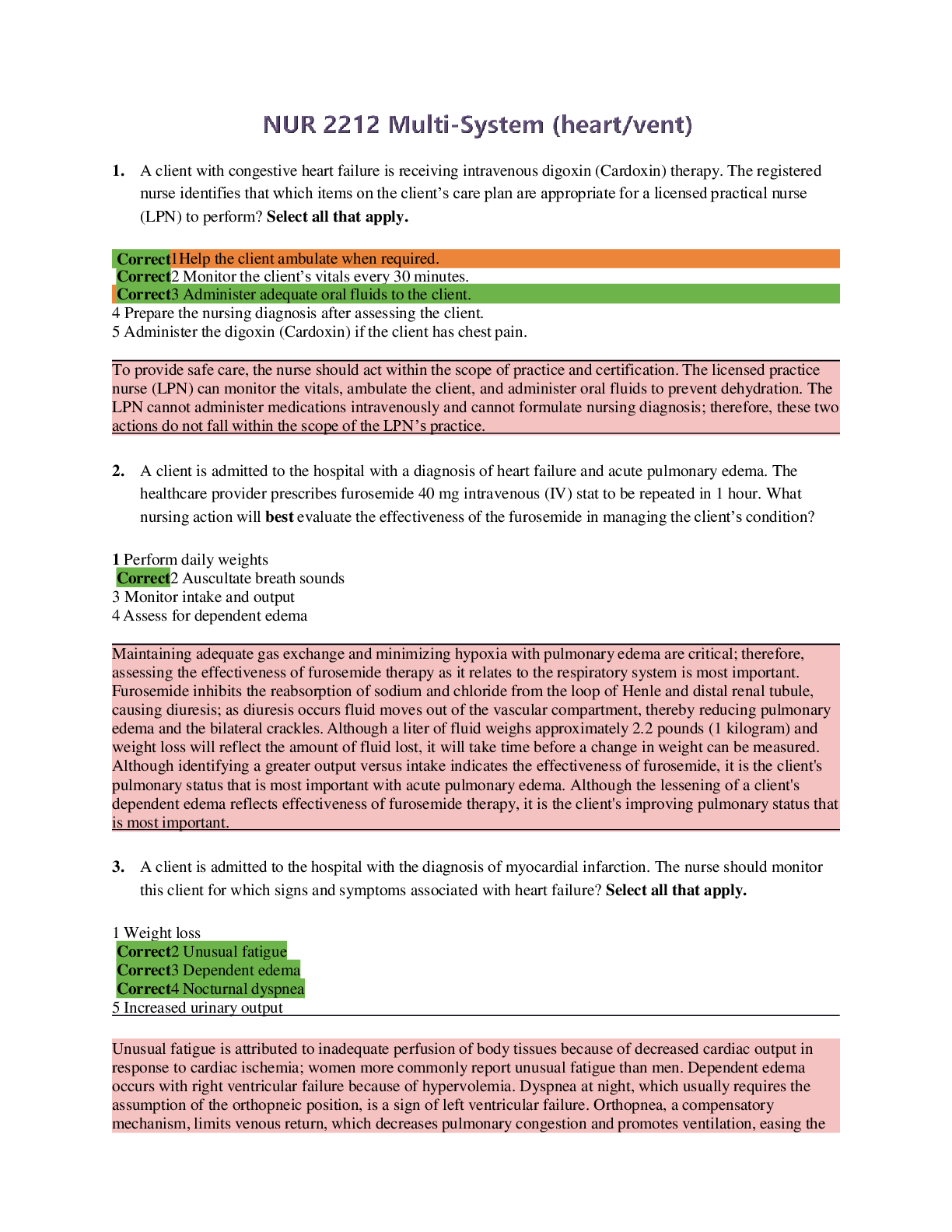
Reviews( 0 )
Document information
Connected school, study & course
About the document
Uploaded On
Apr 04, 2021
Number of pages
34
Written in
Additional information
This document has been written for:
Uploaded
Apr 04, 2021
Downloads
0
Views
39

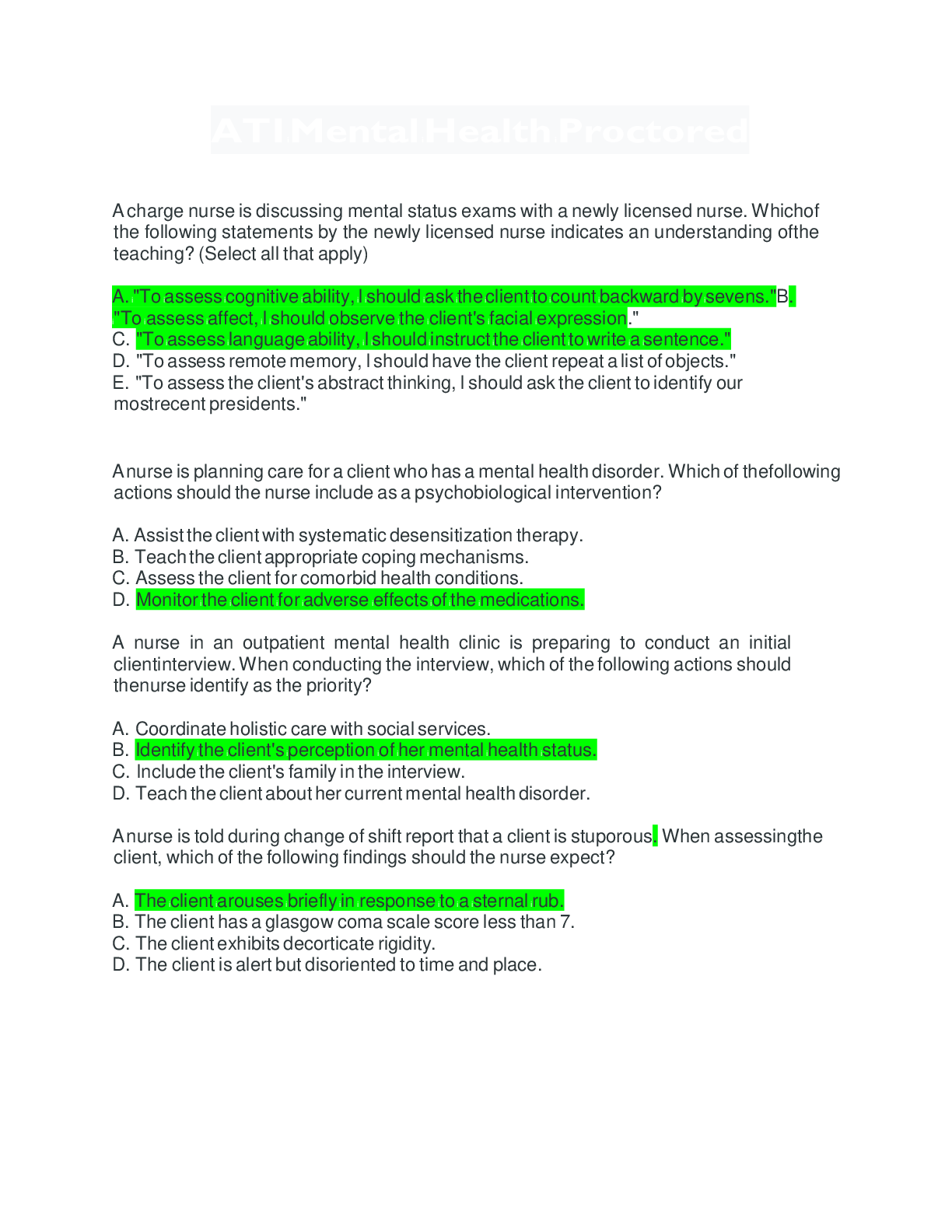
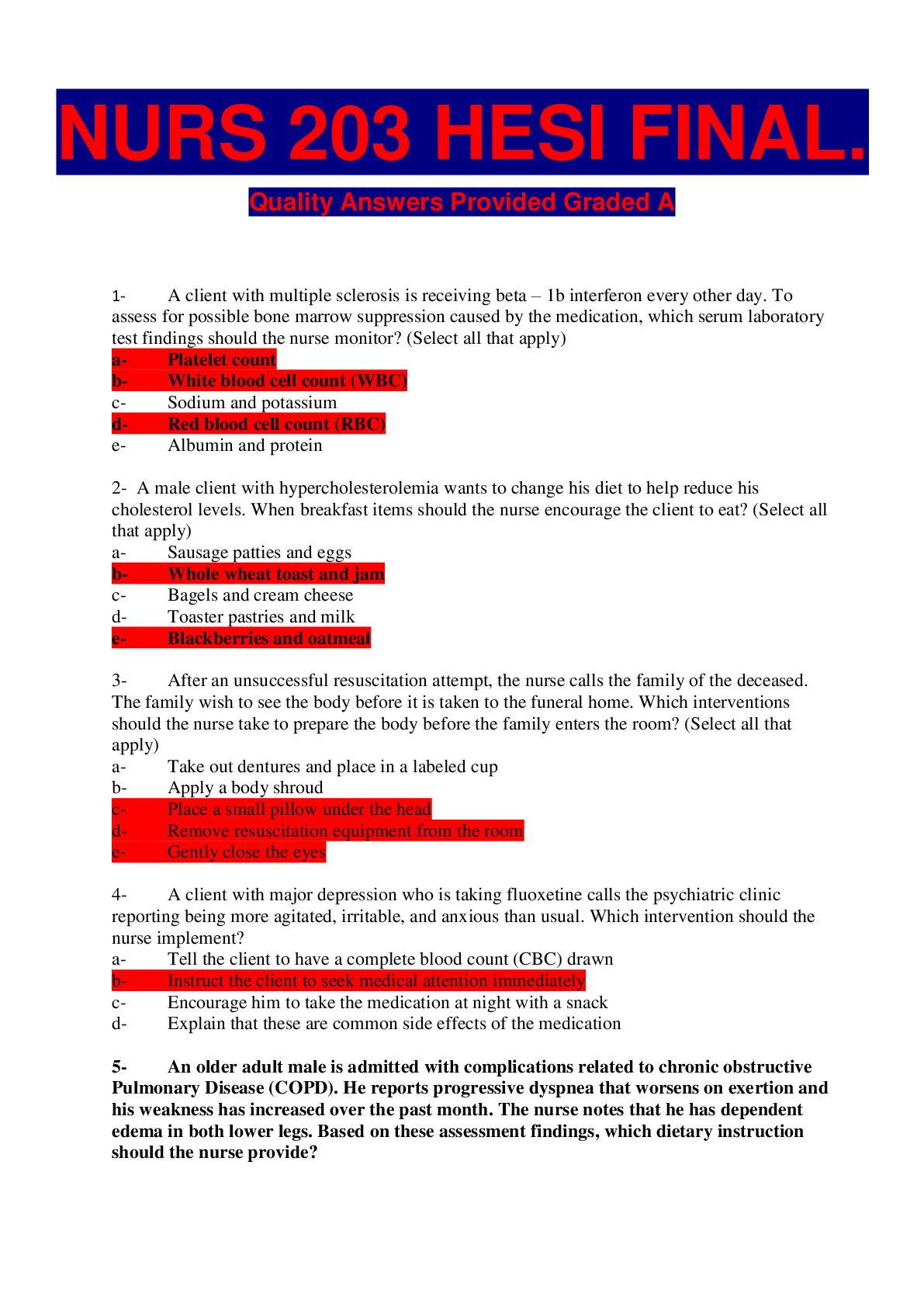
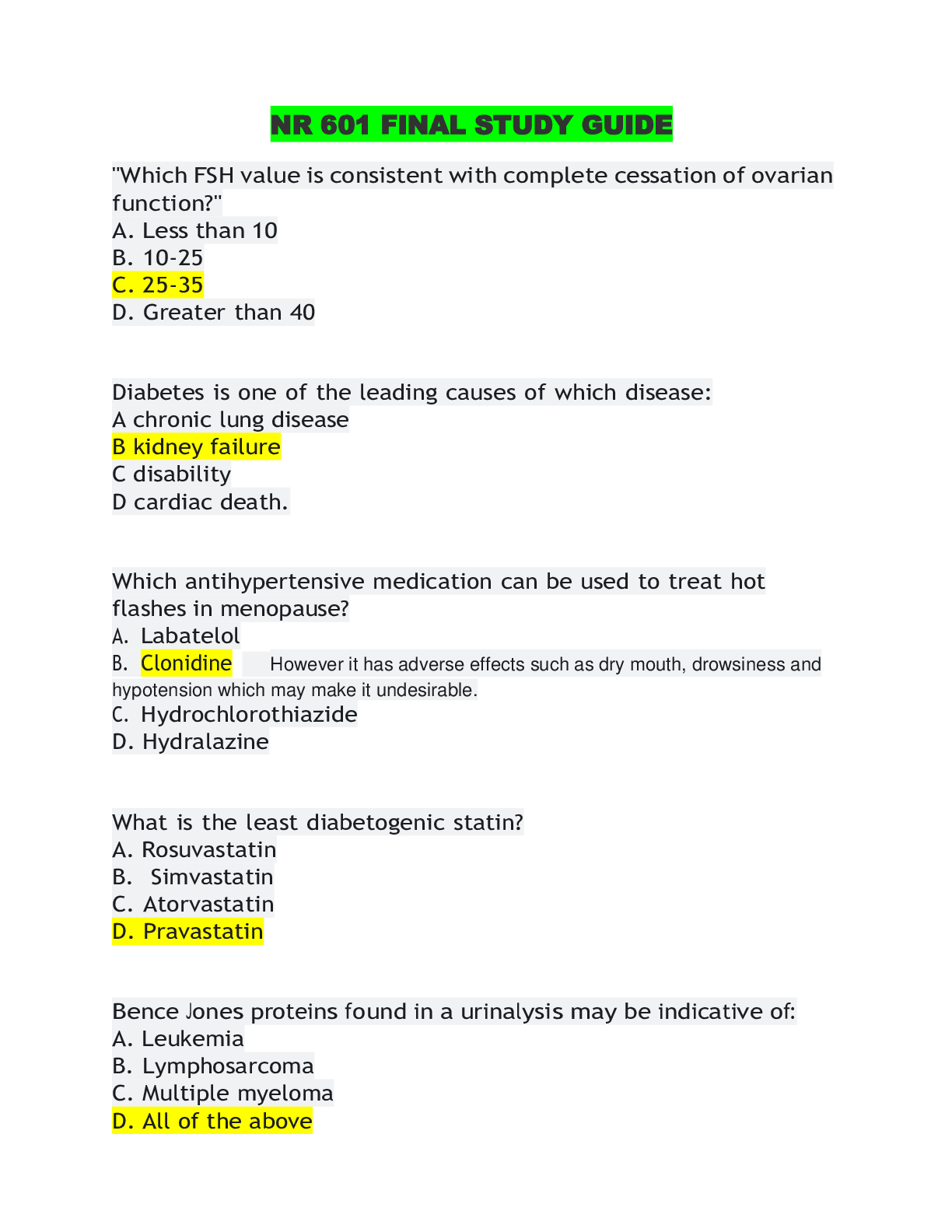
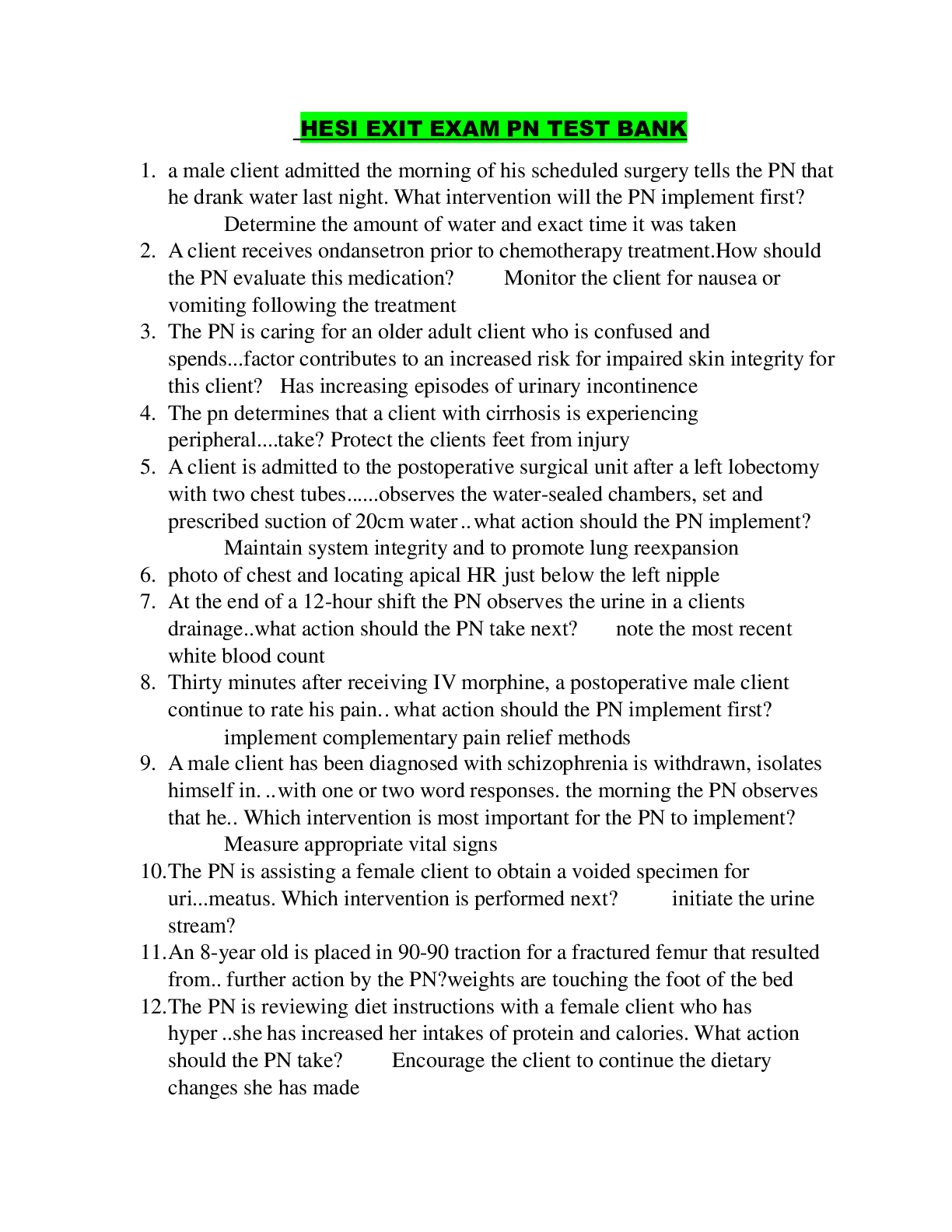
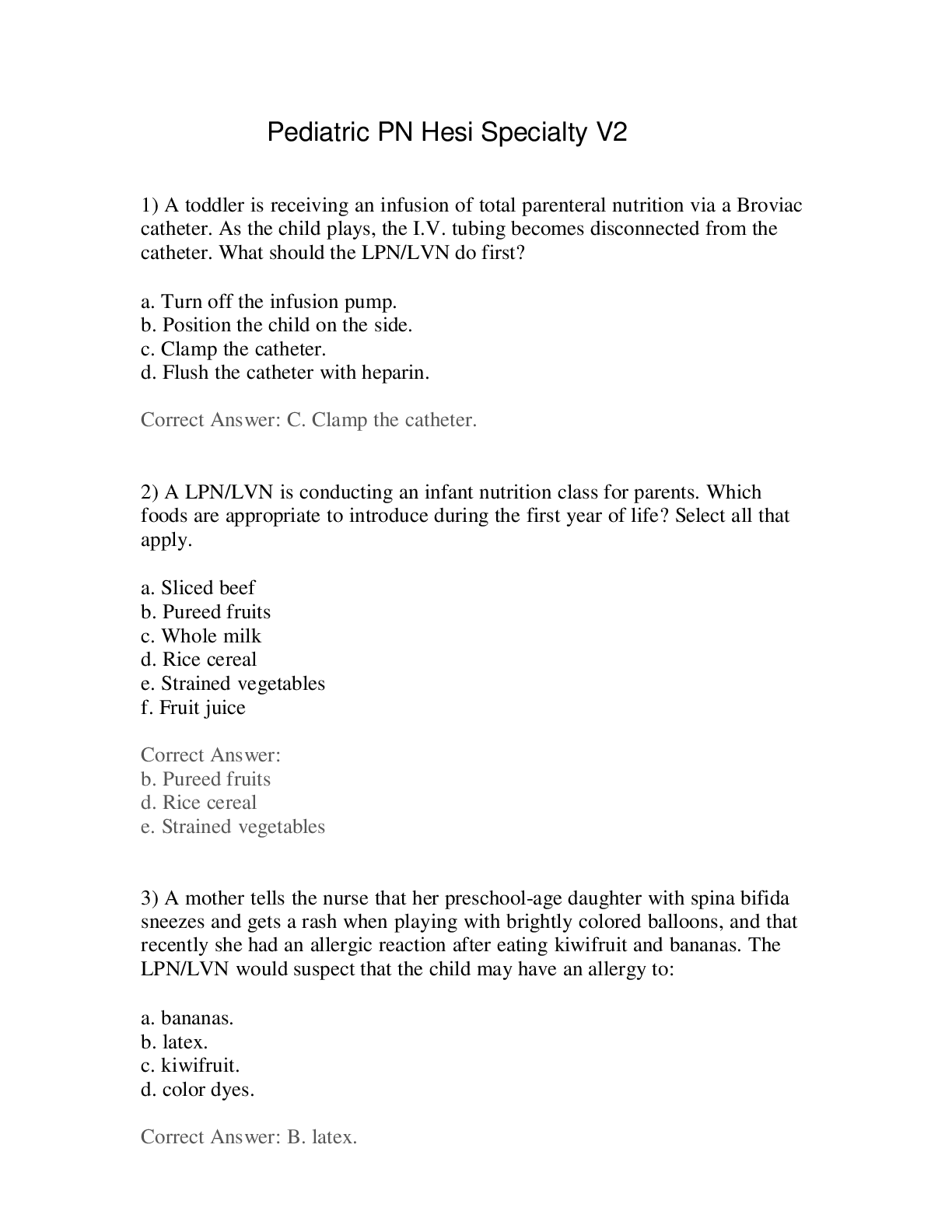
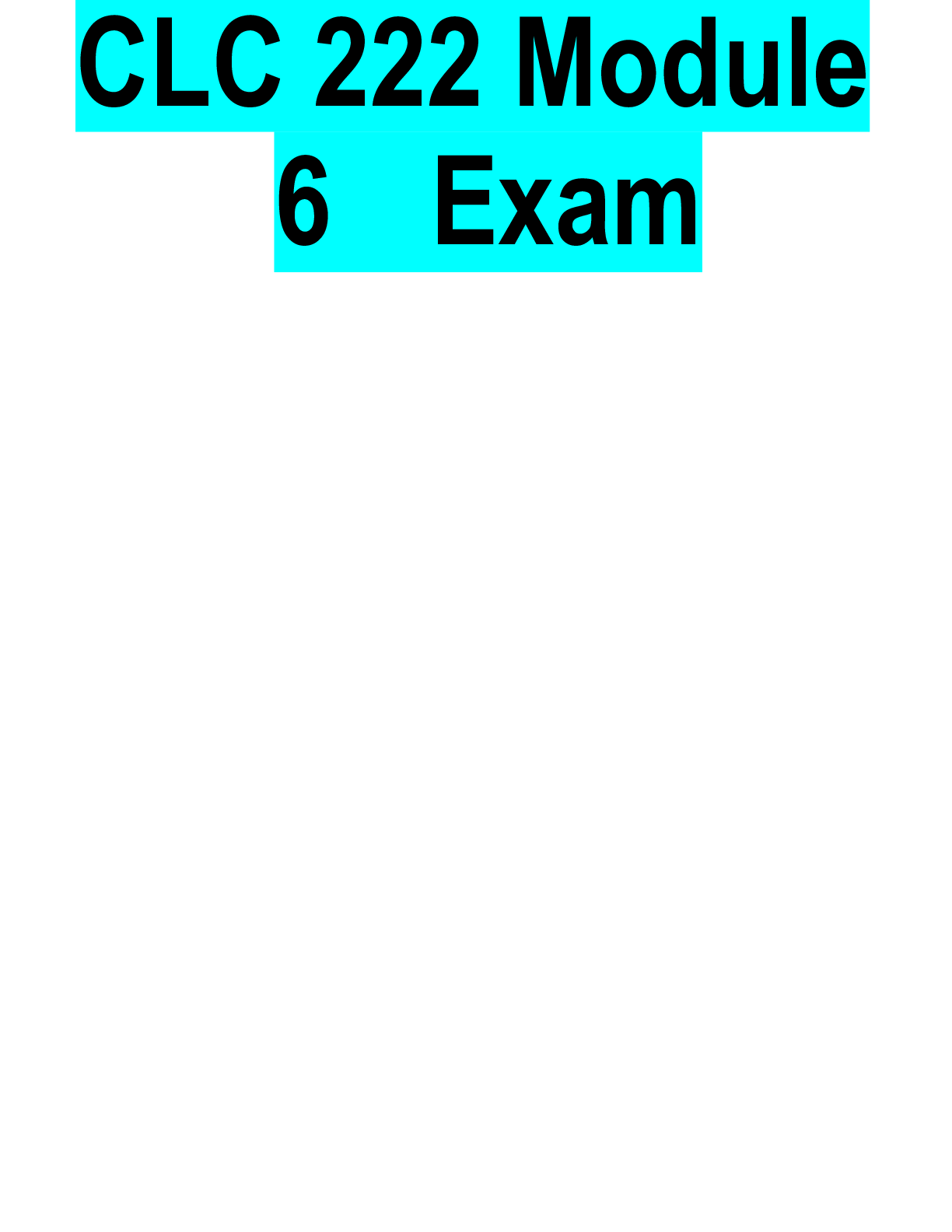
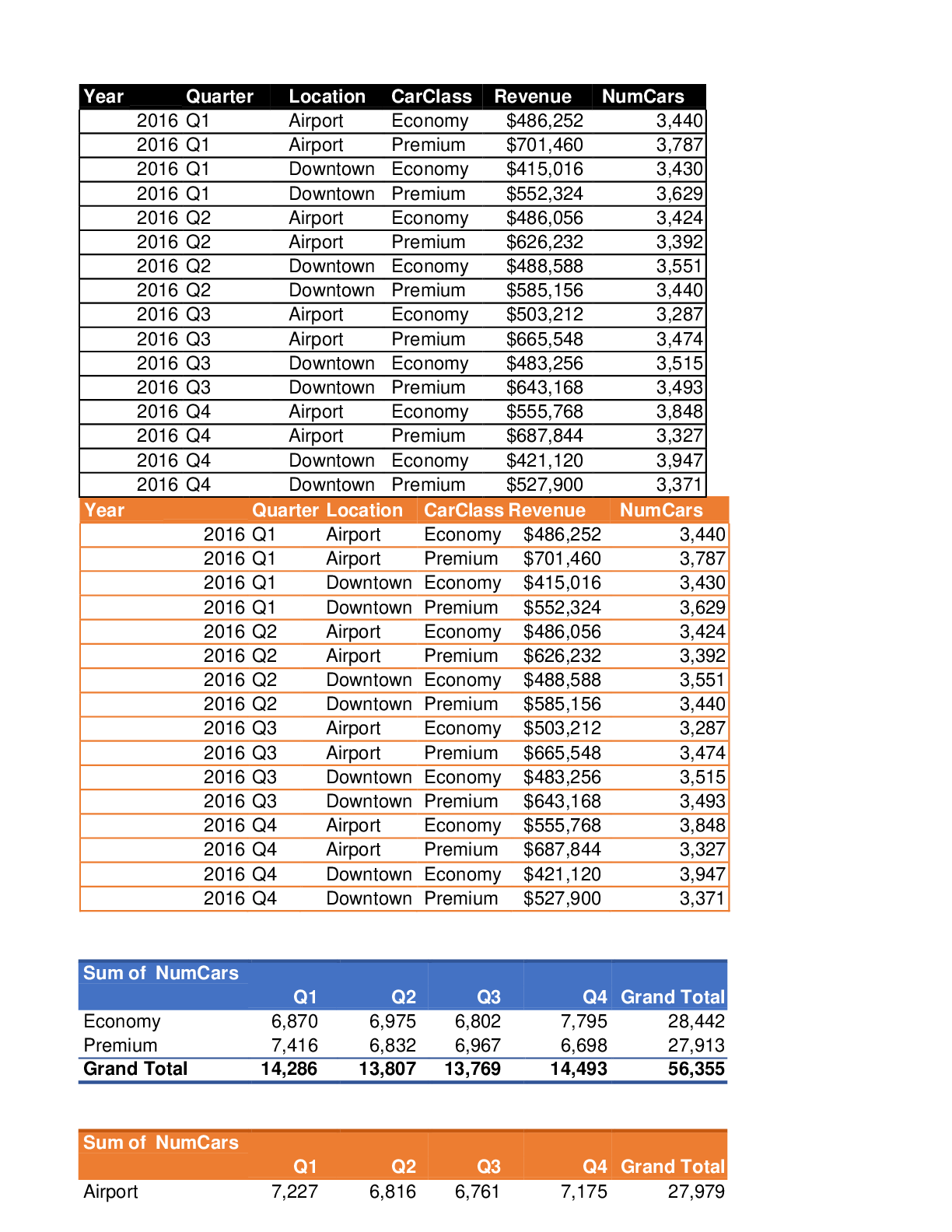
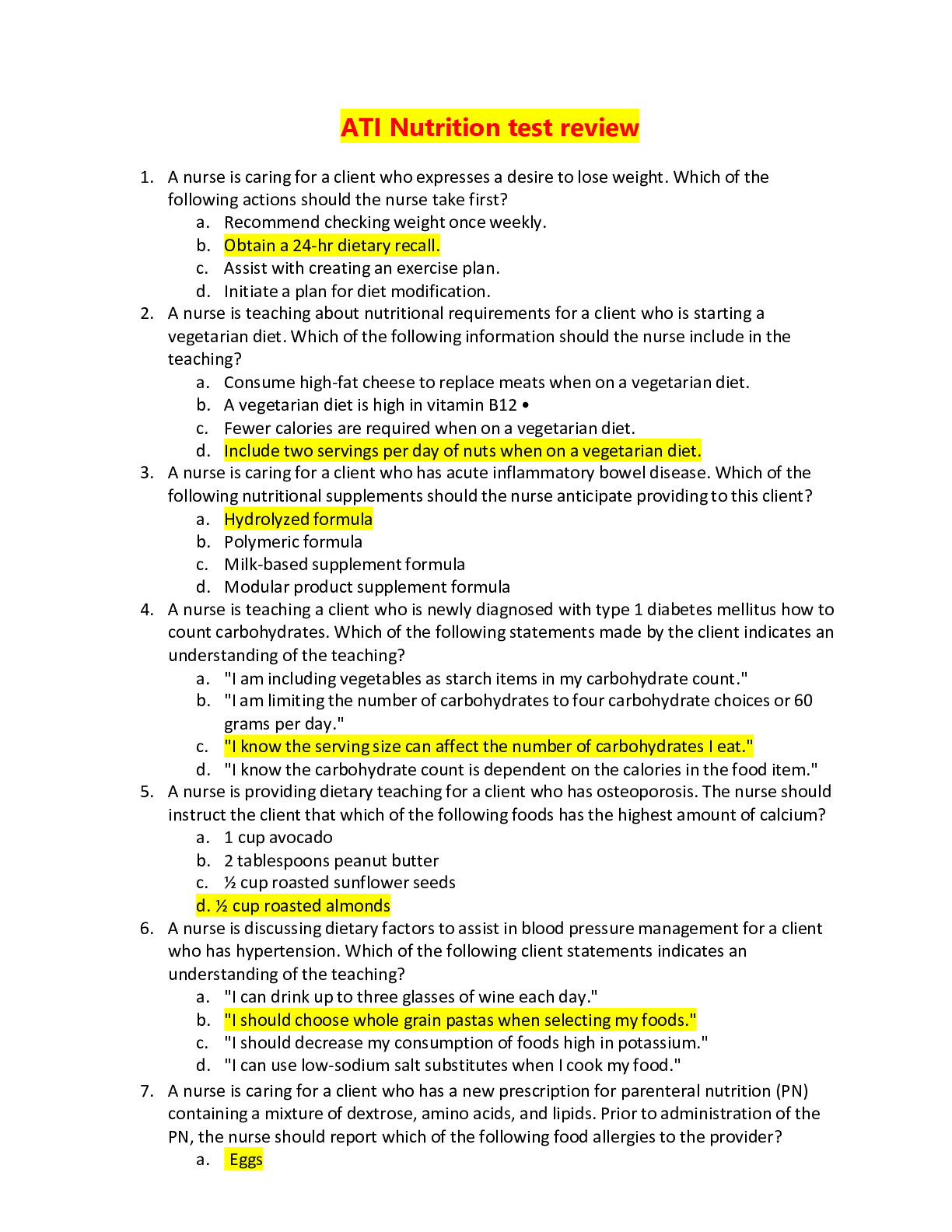
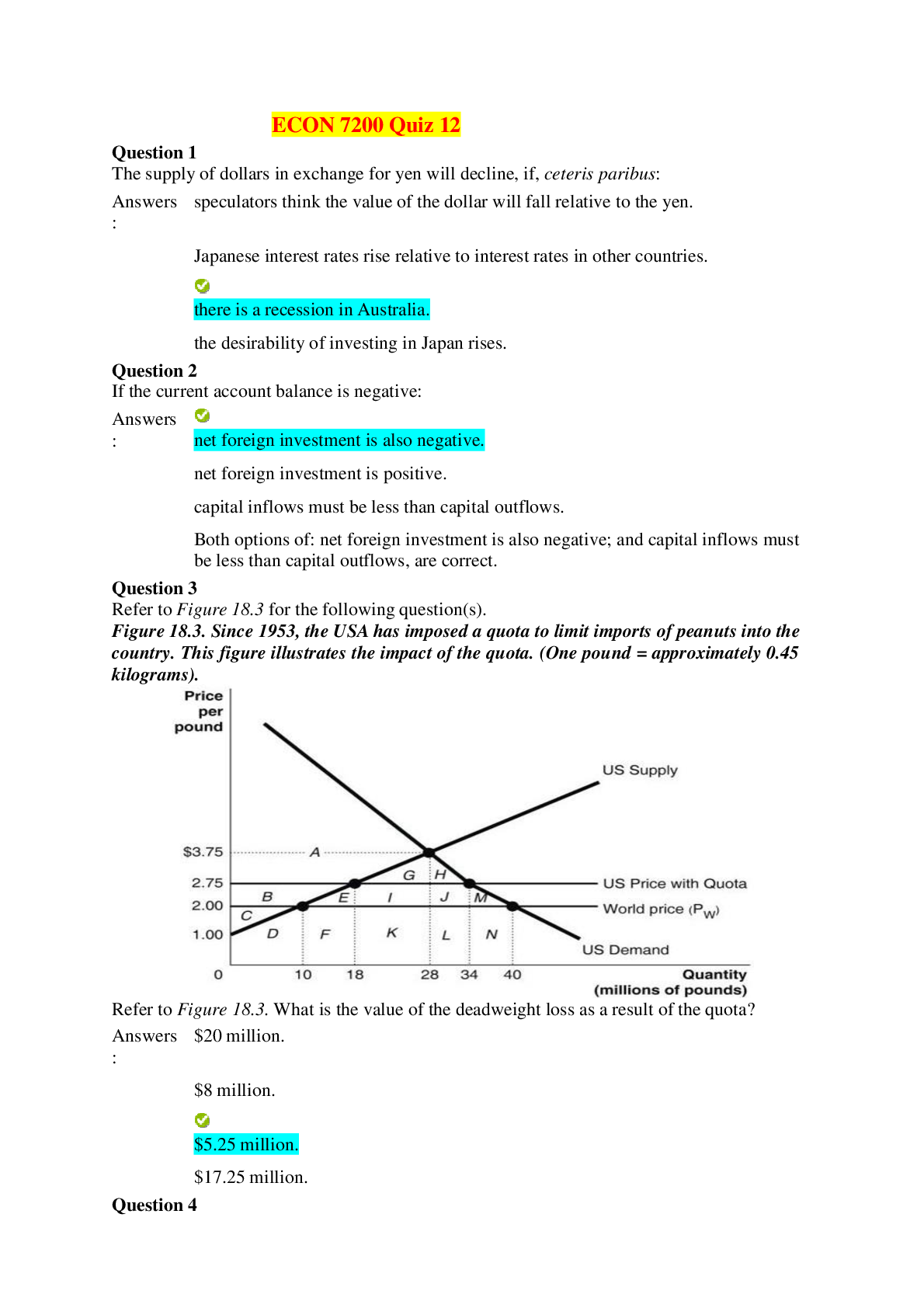
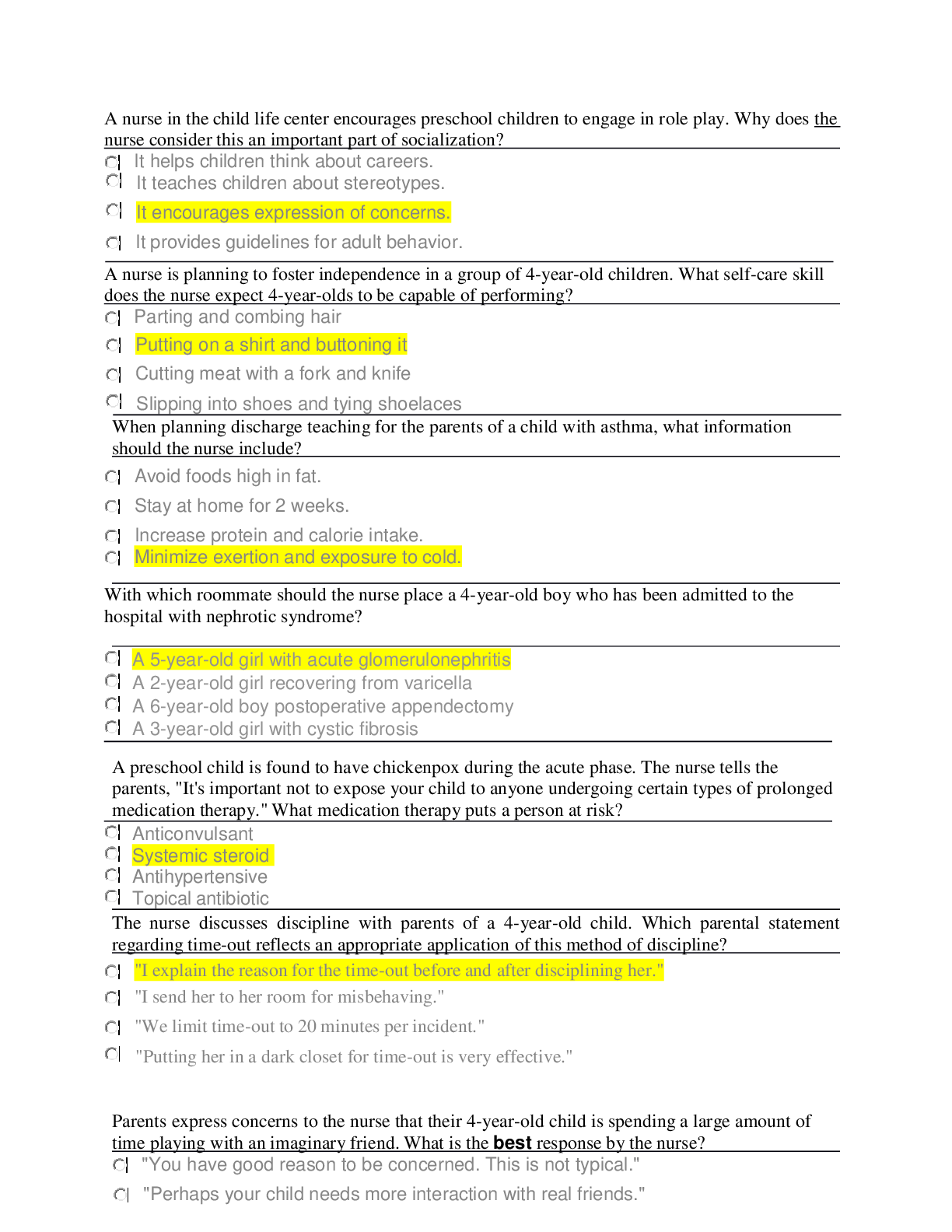
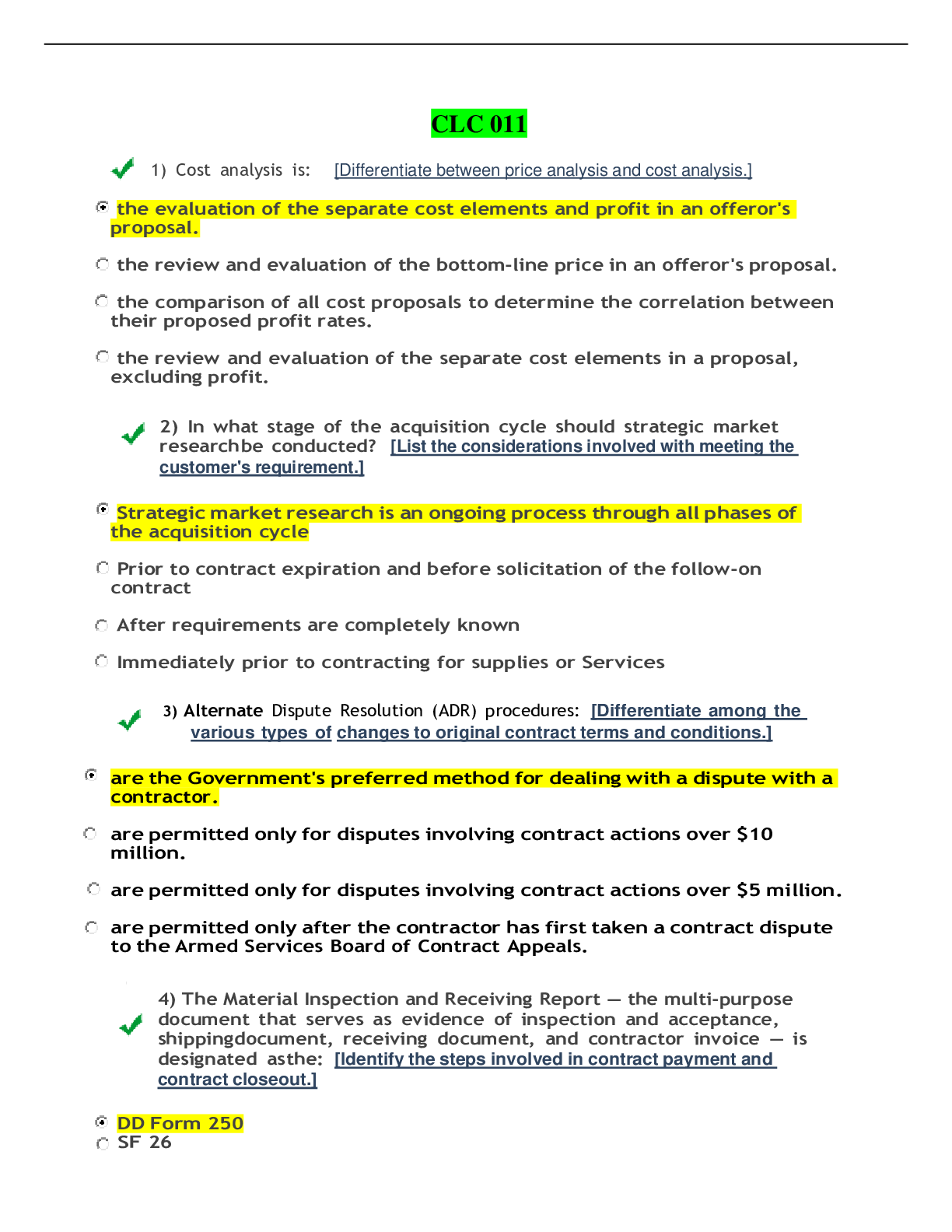
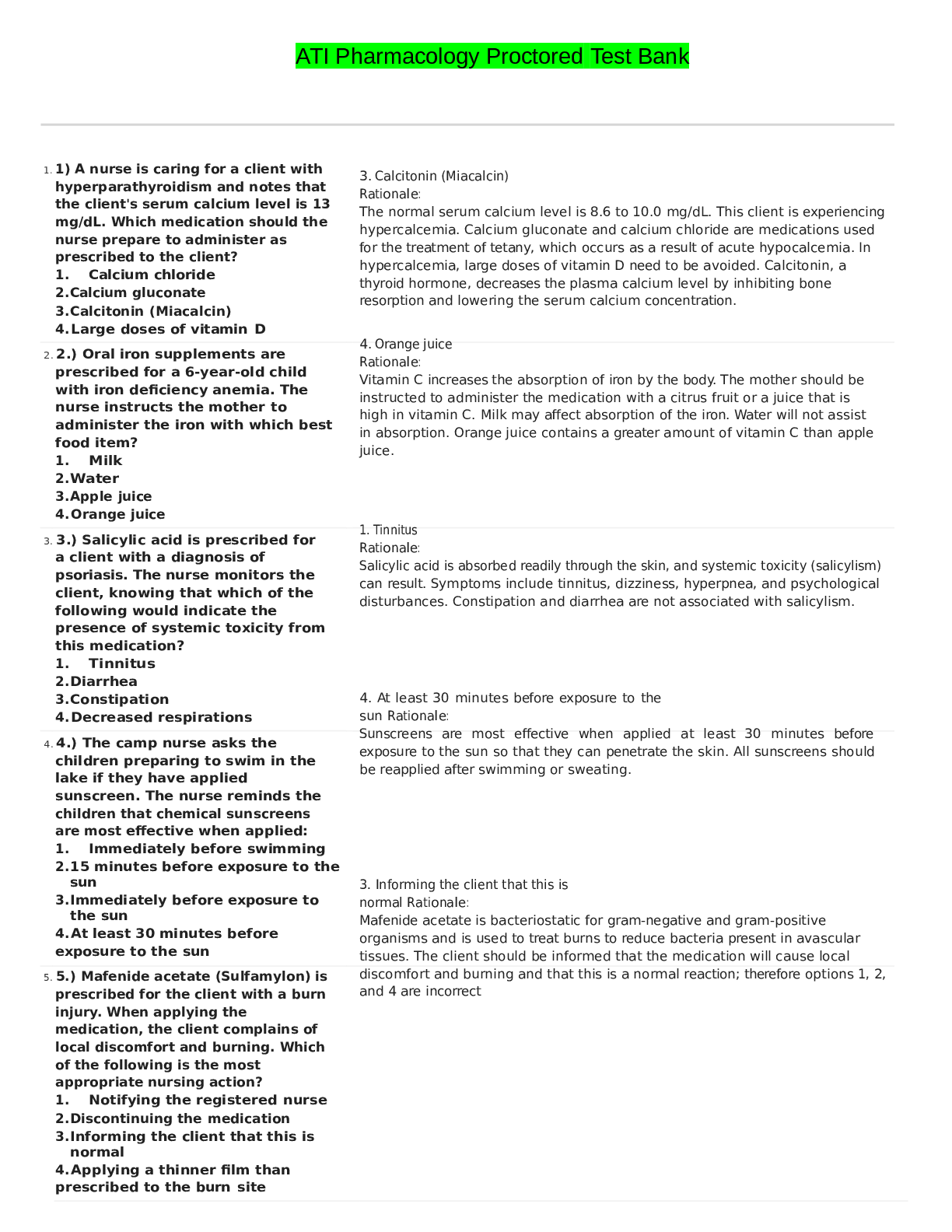
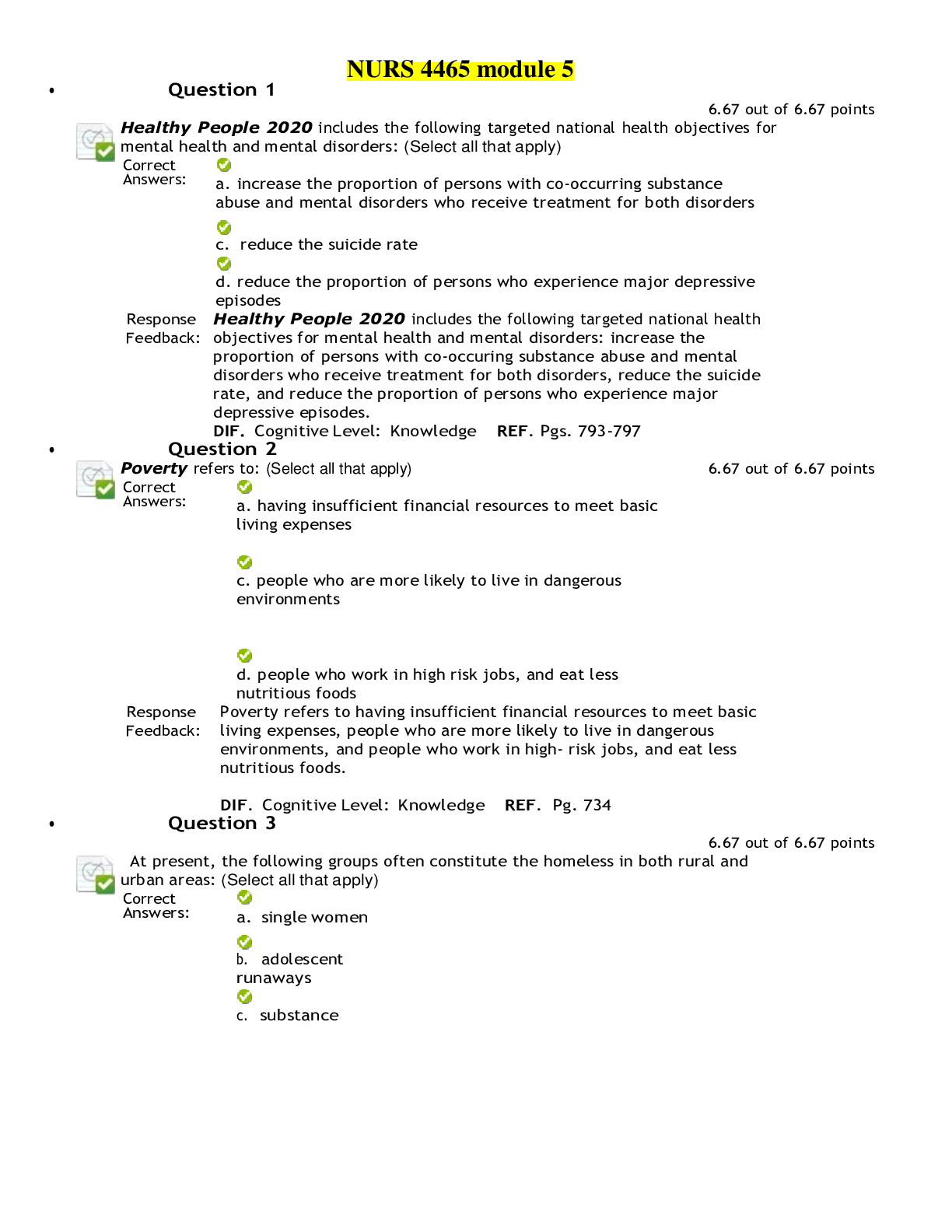
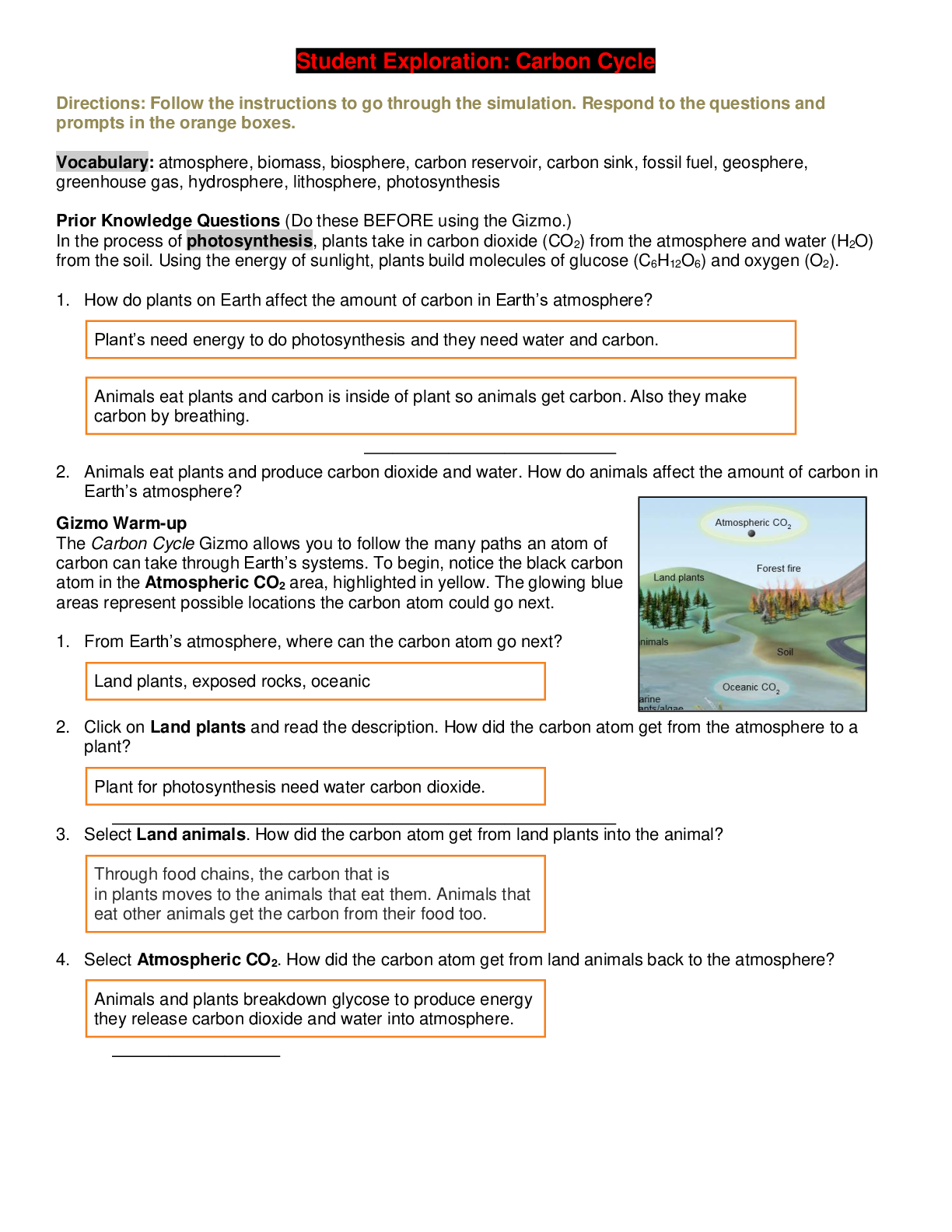
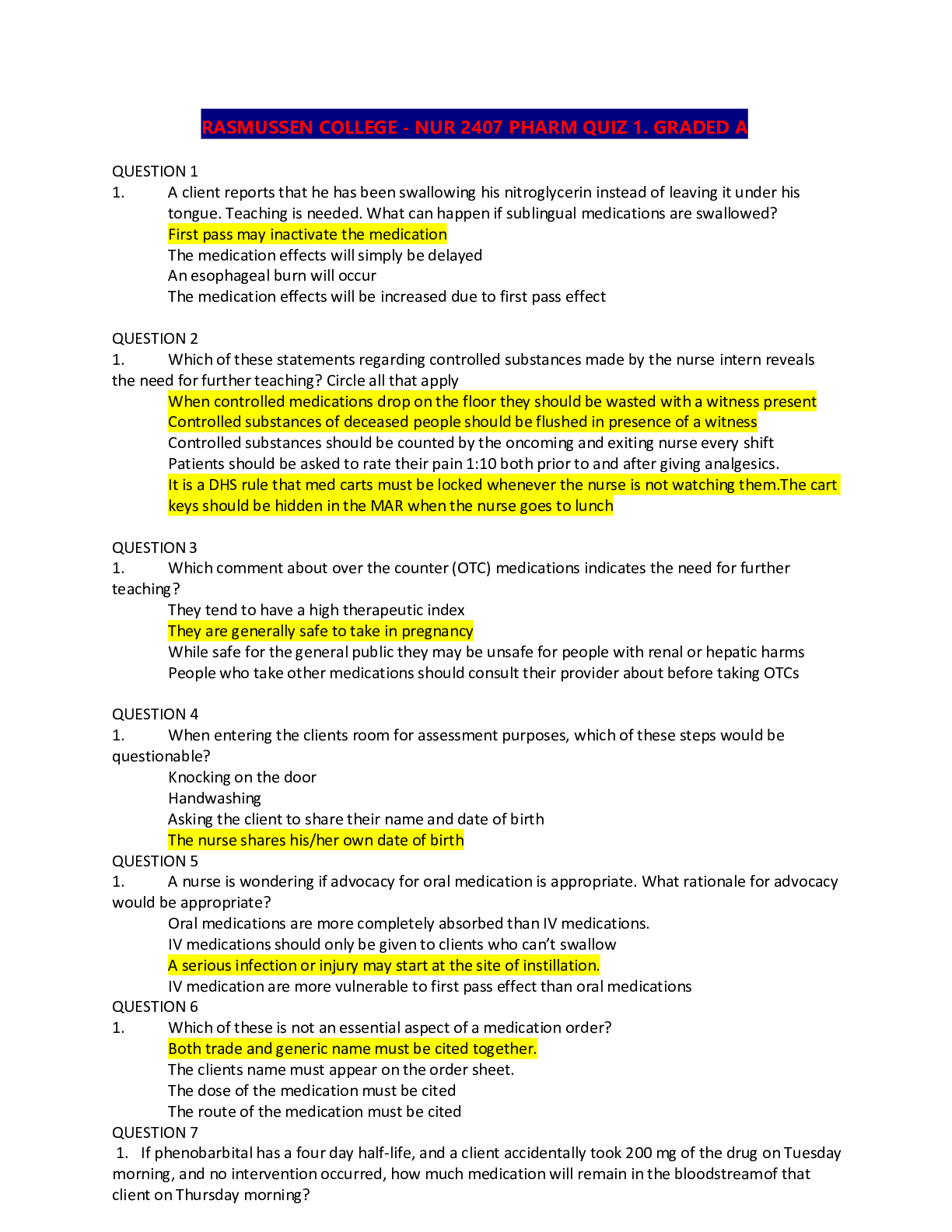
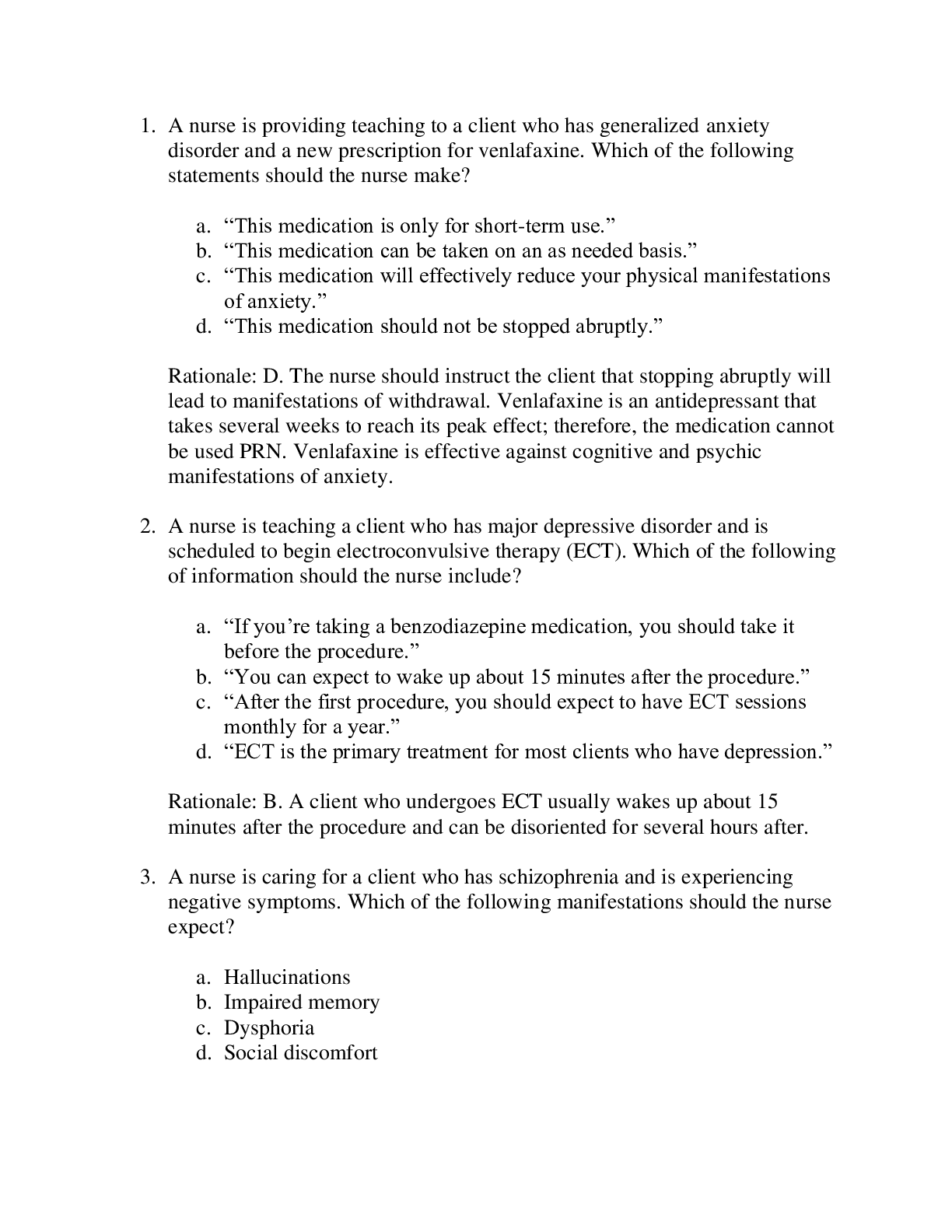
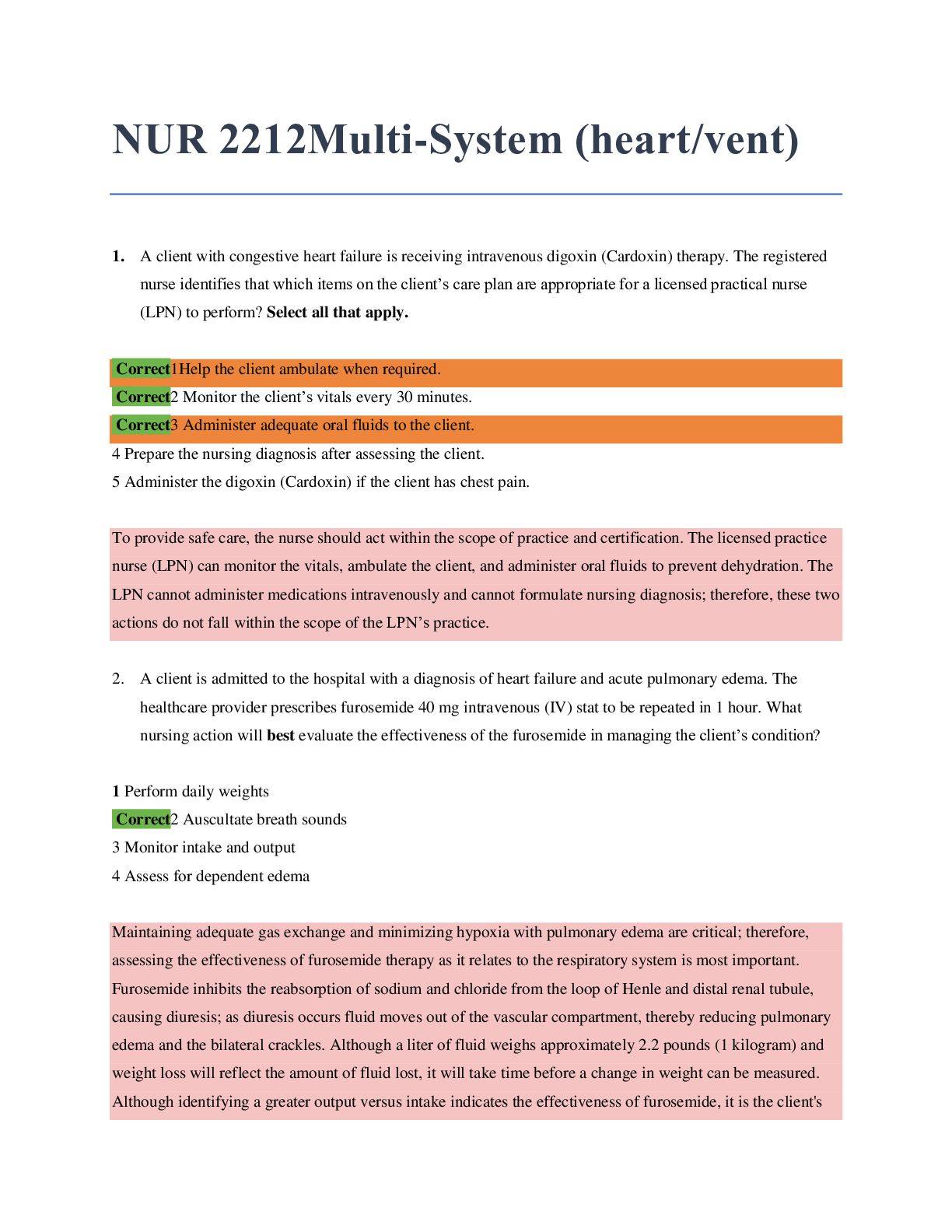



.png)

.png)

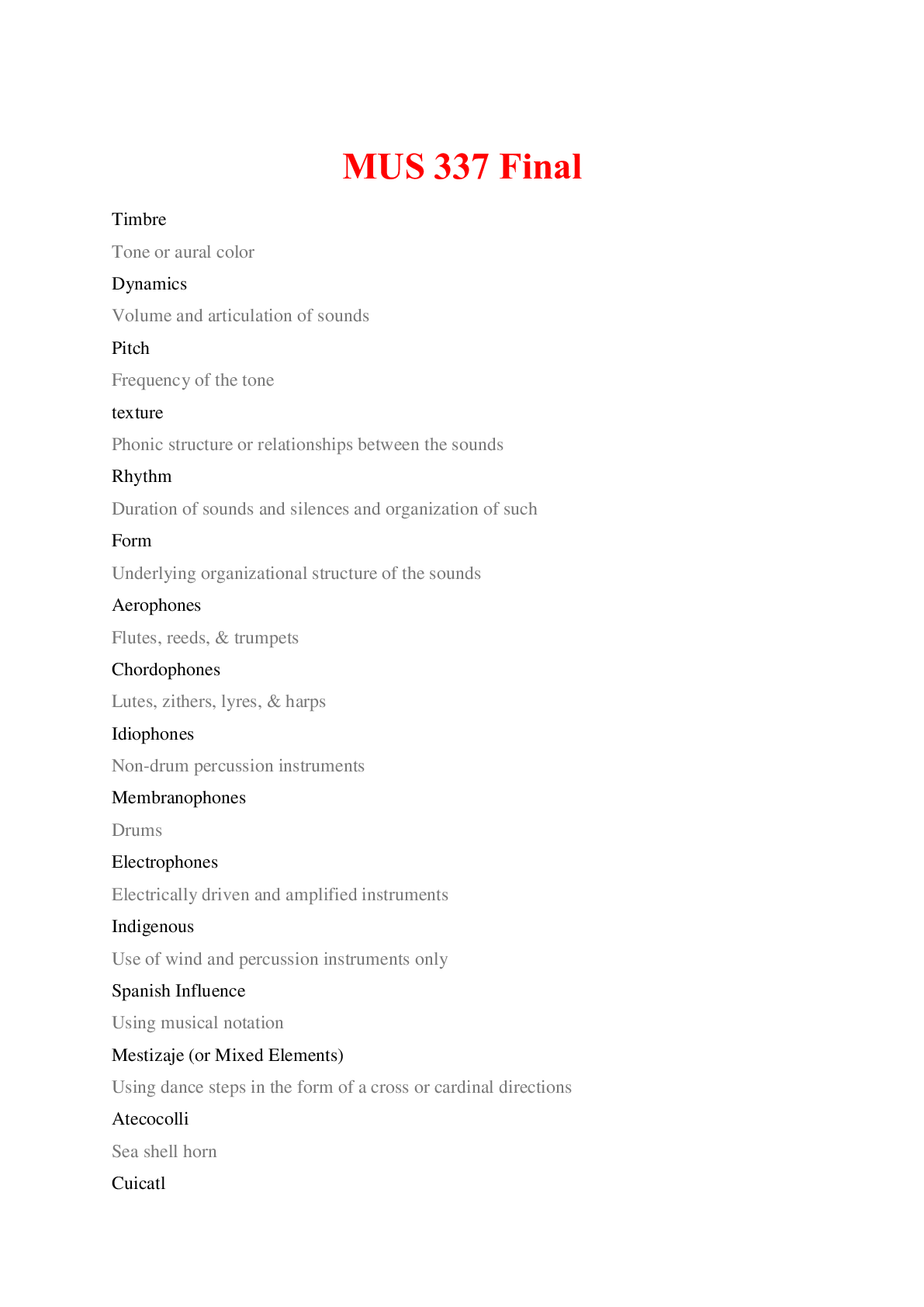

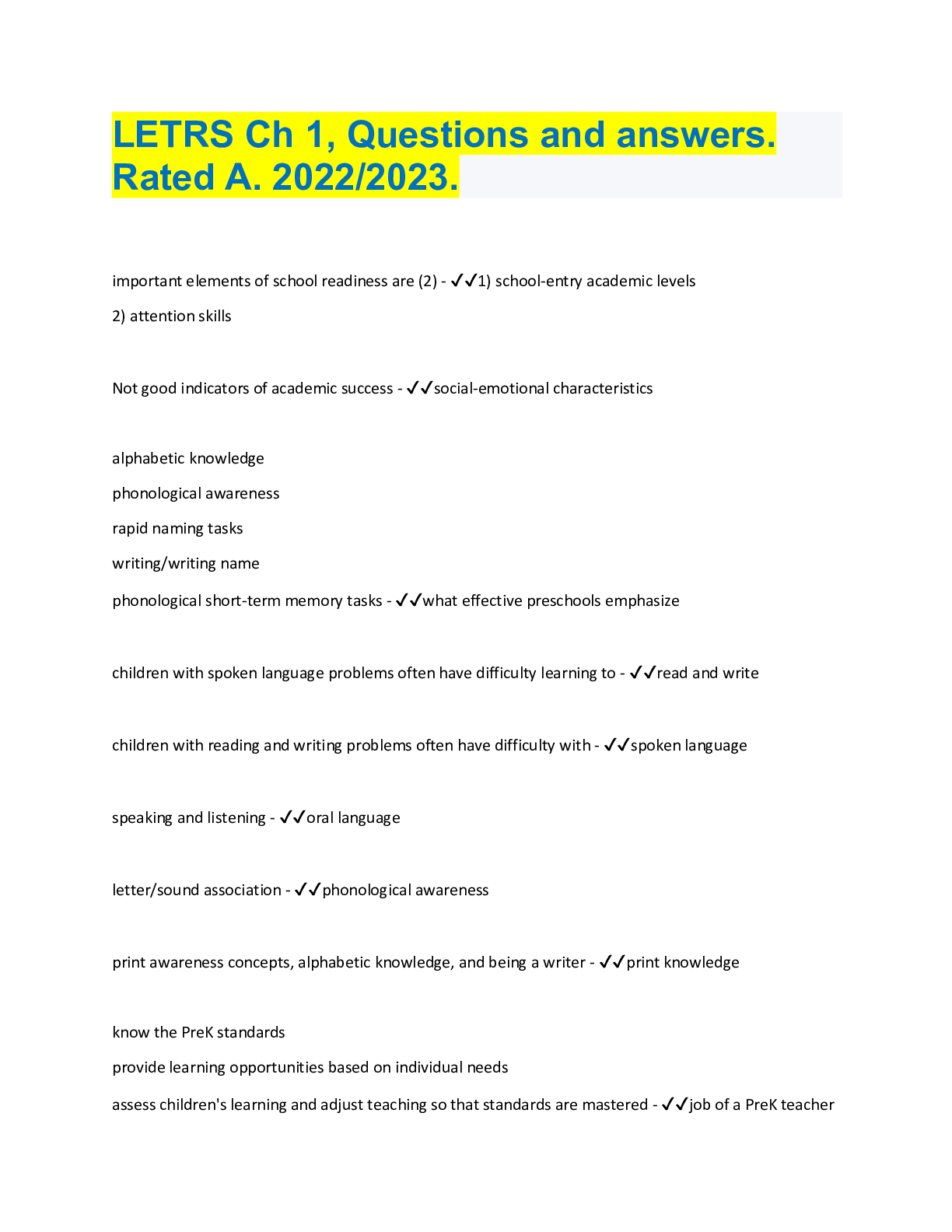
.png)
.png)

.png)
